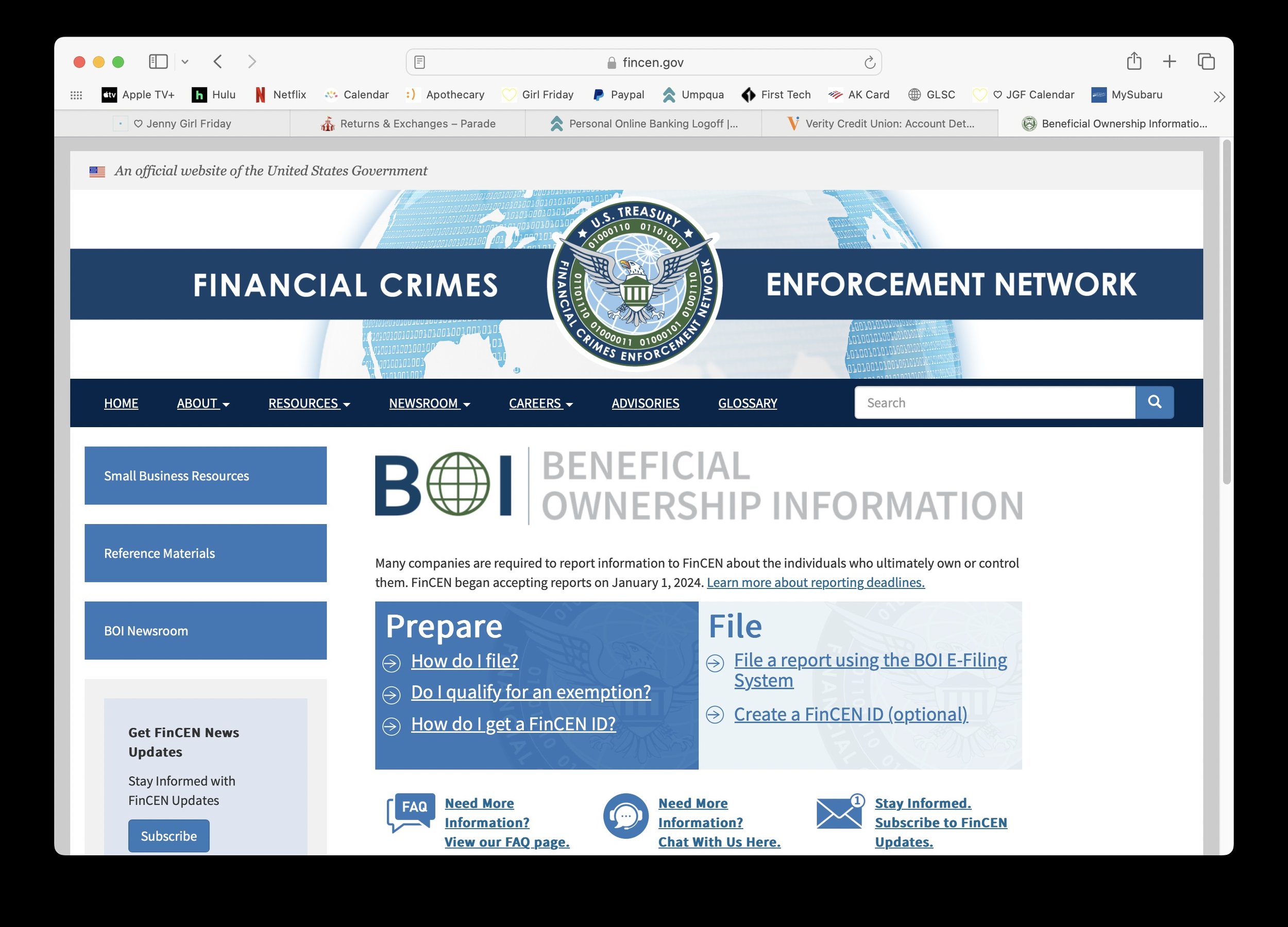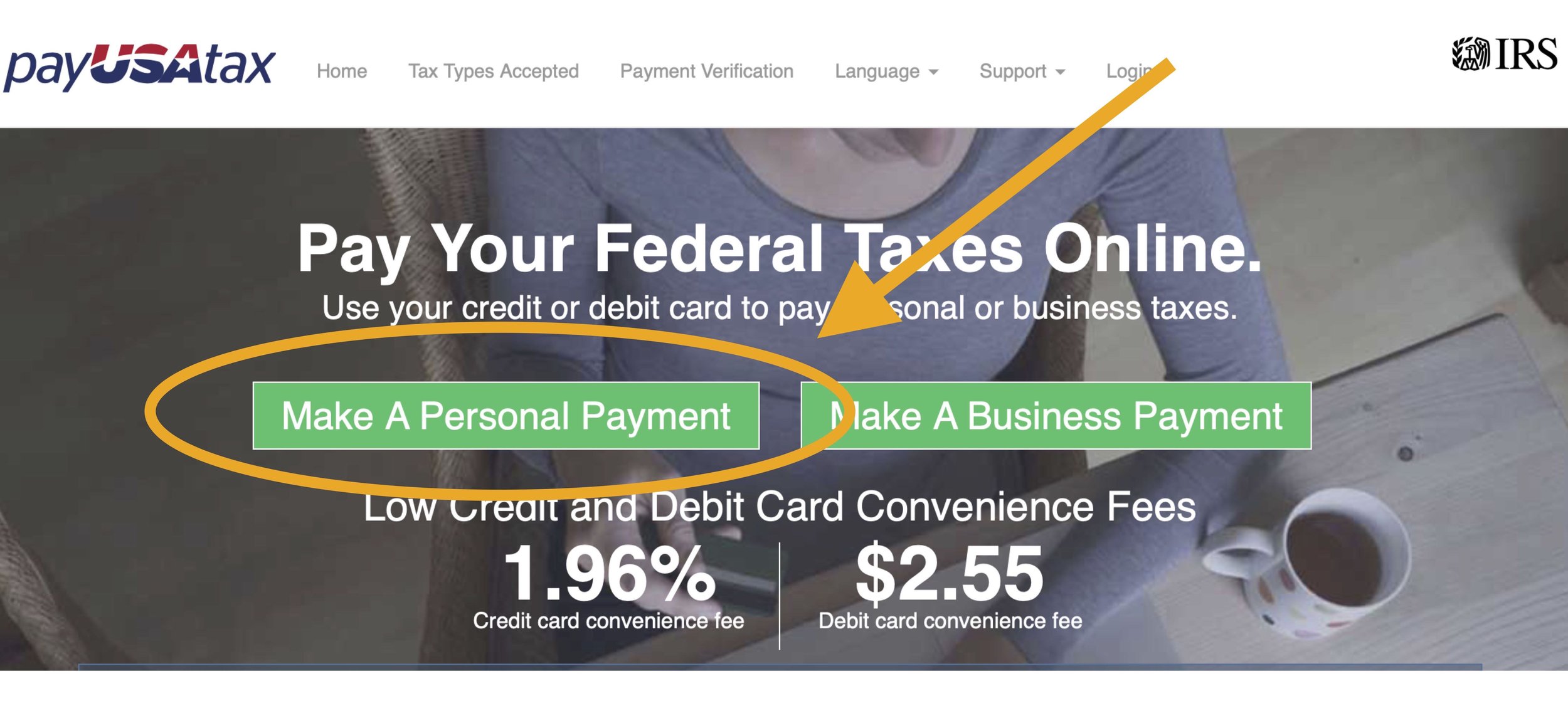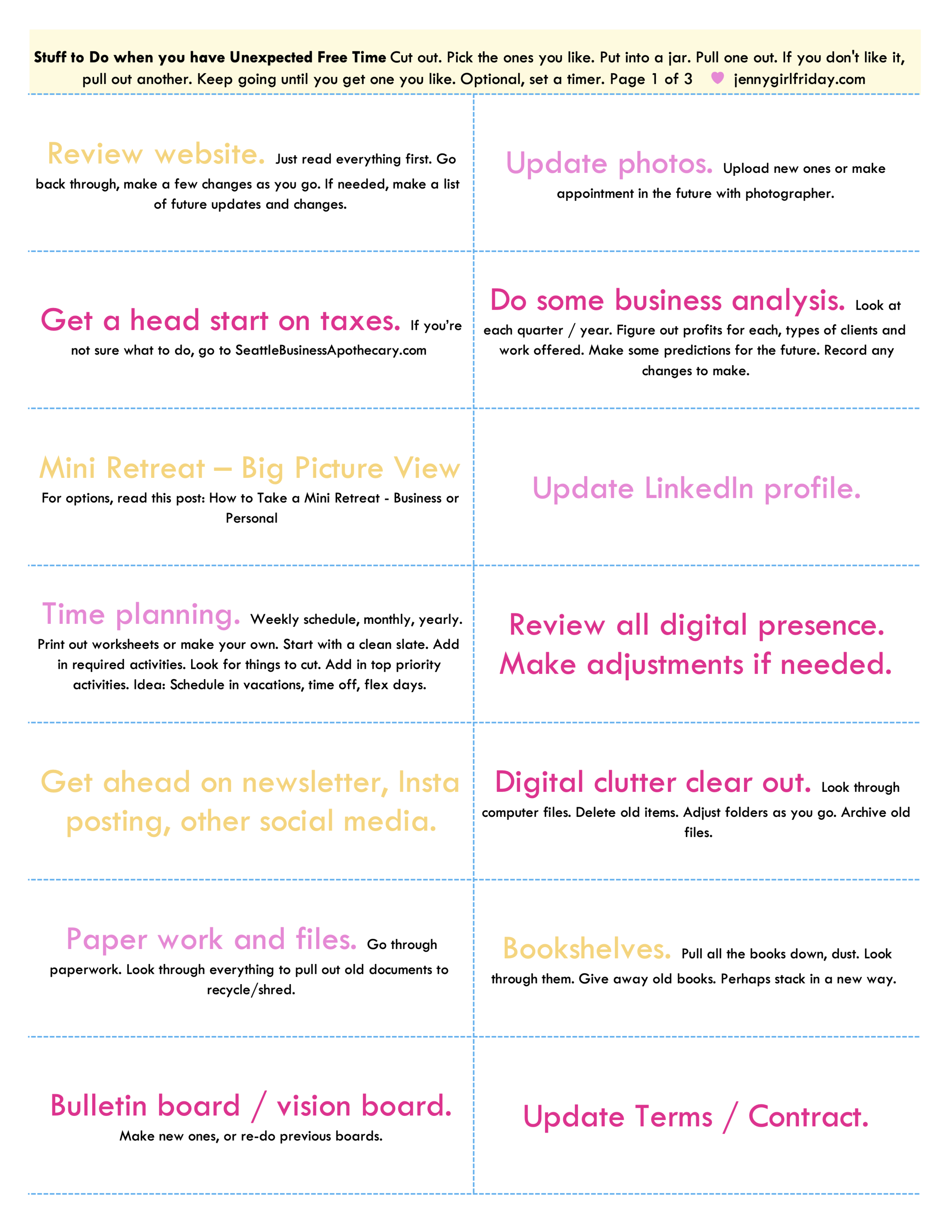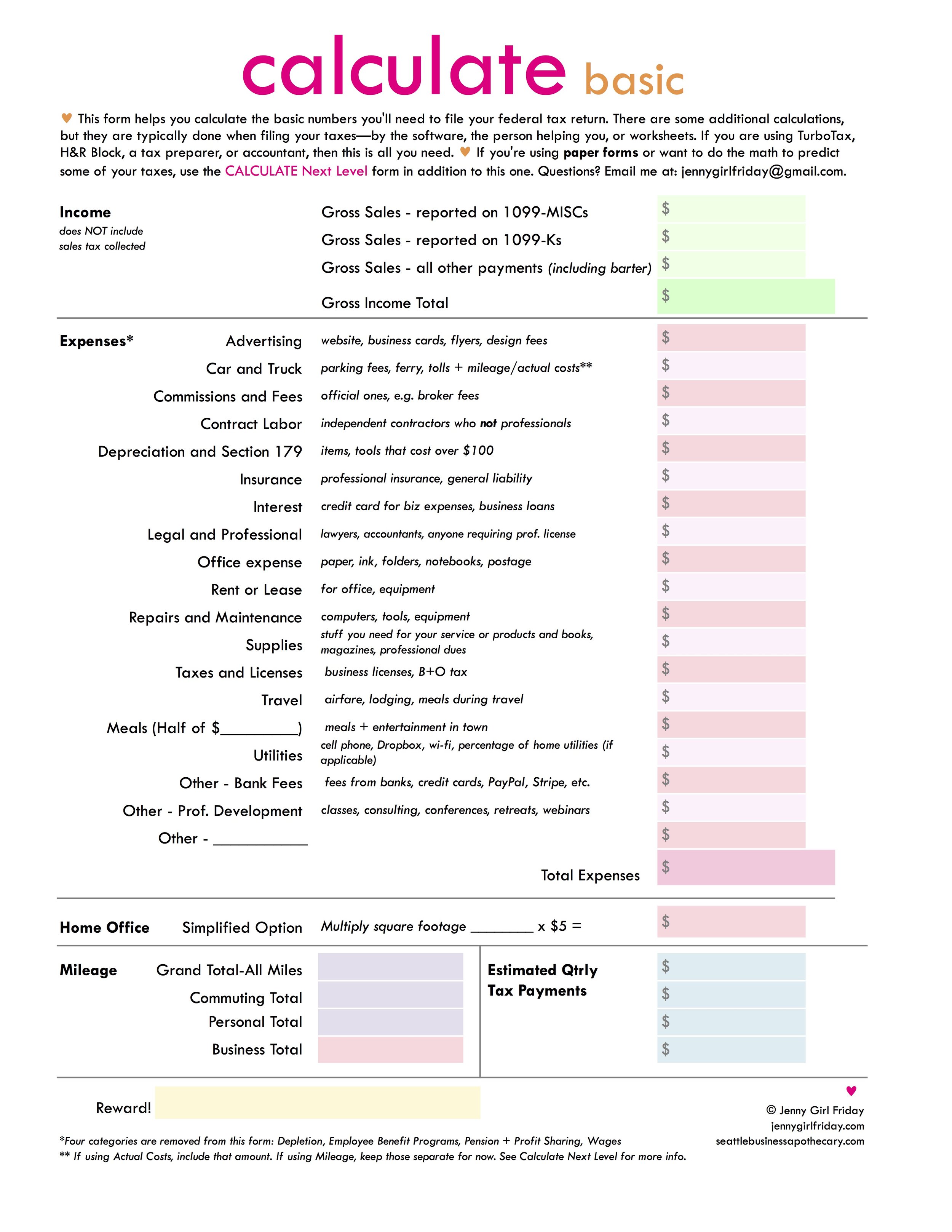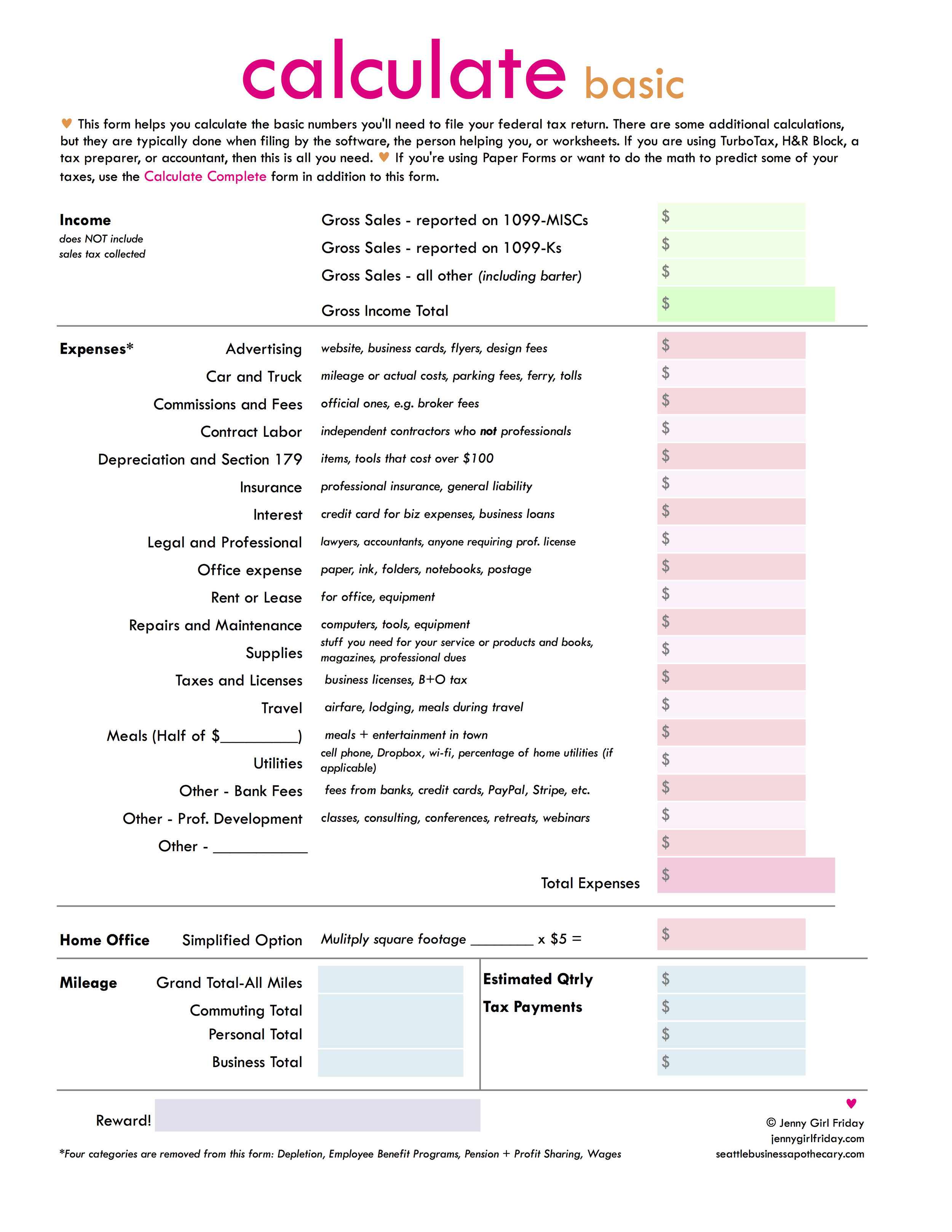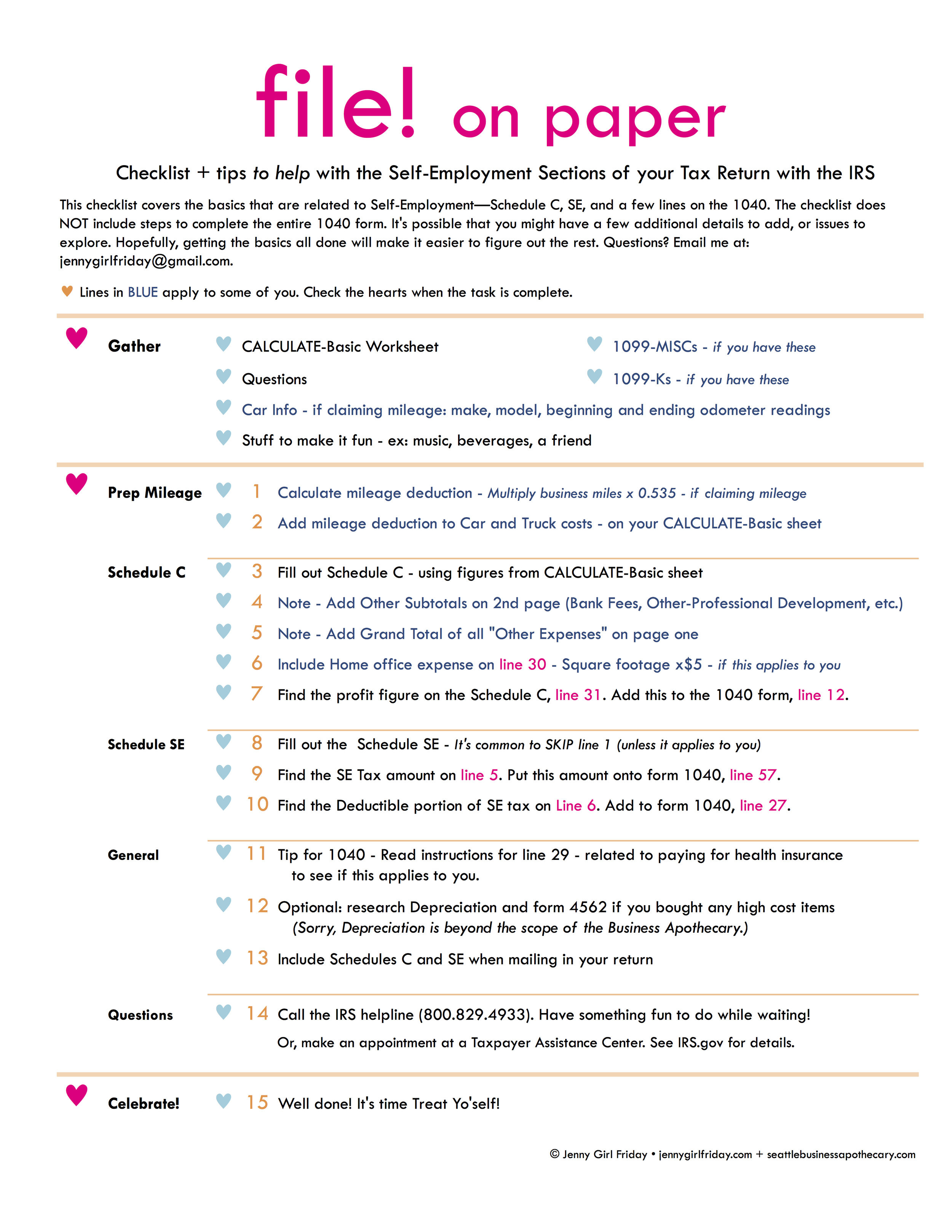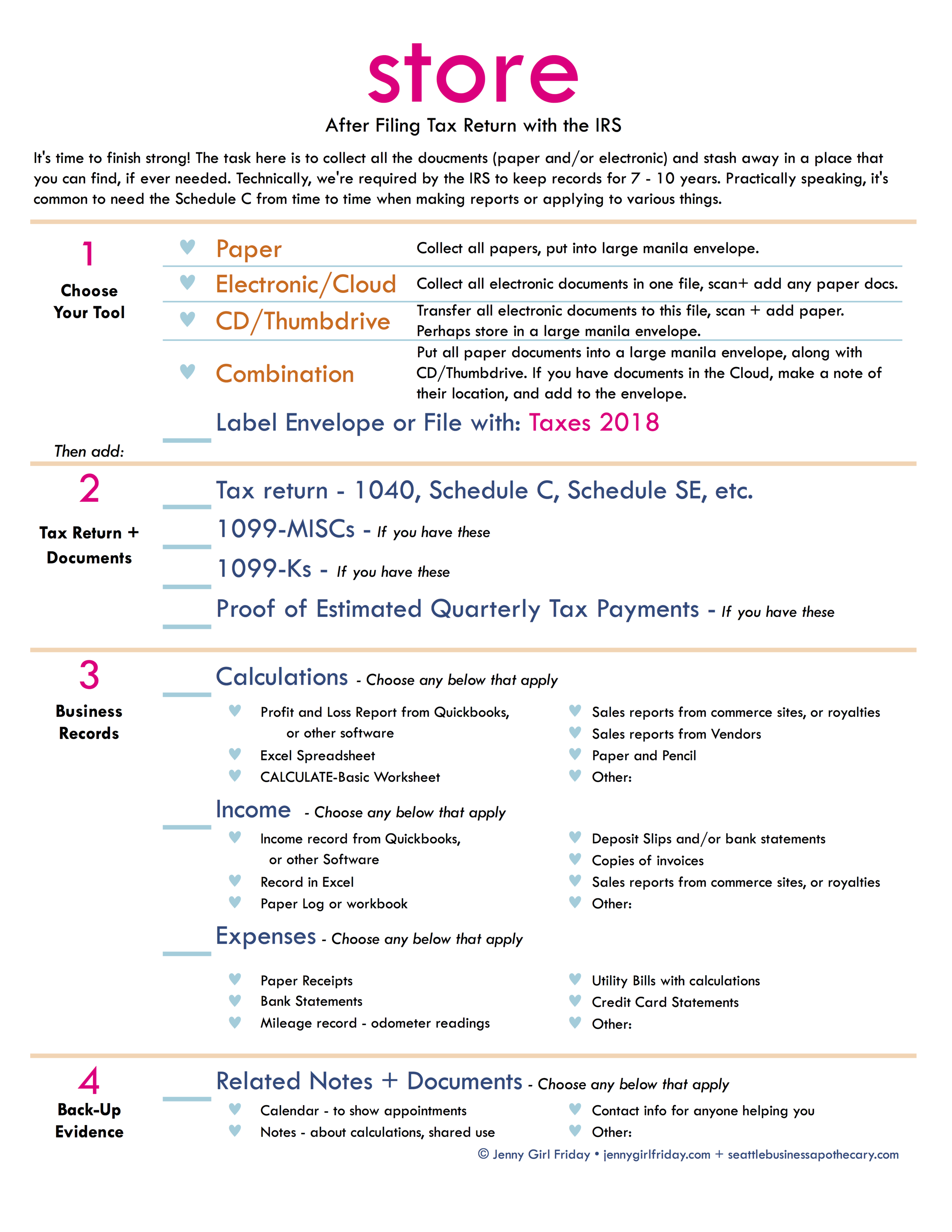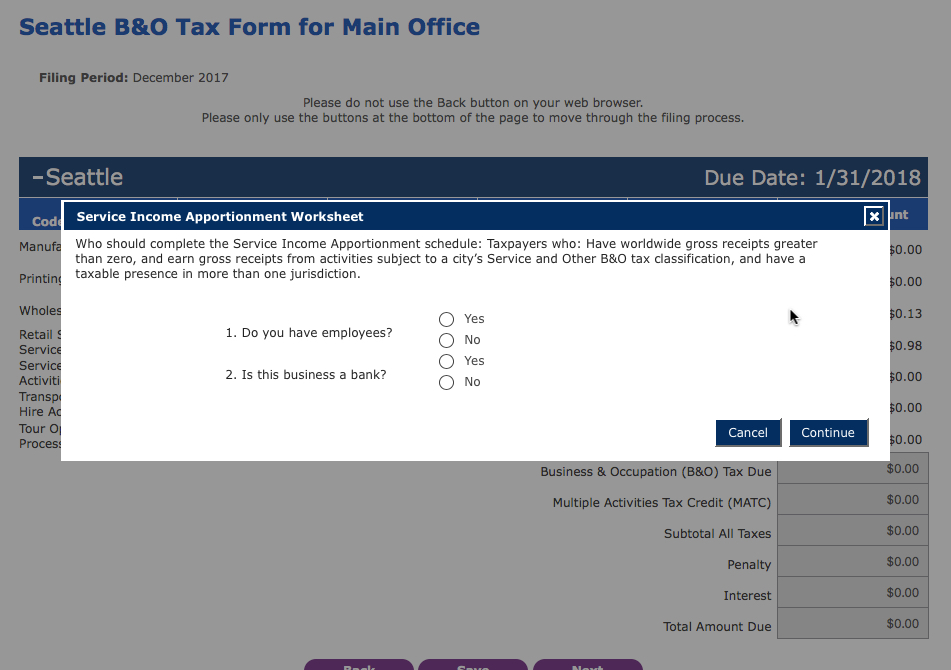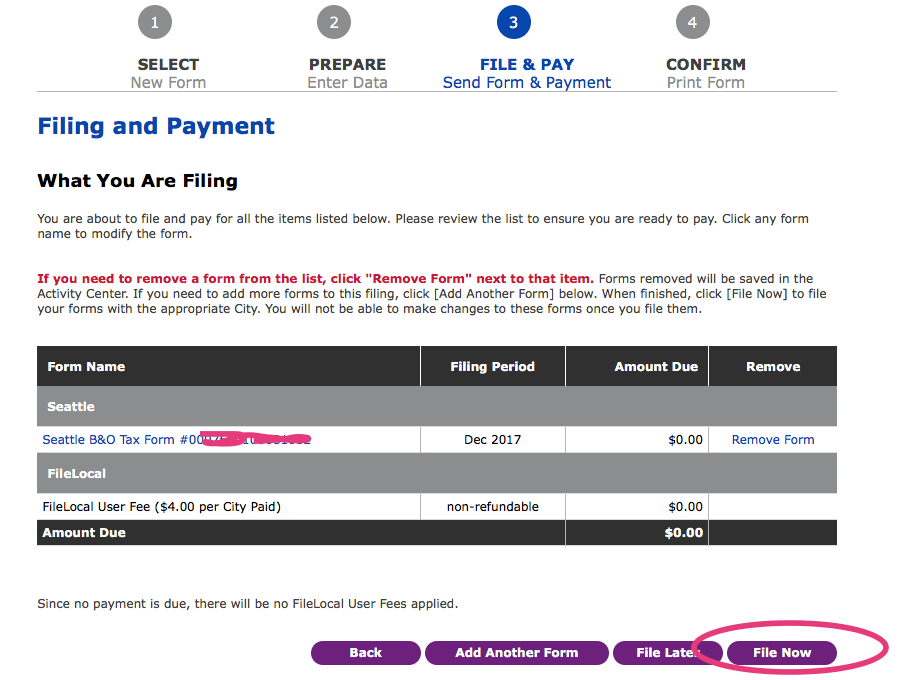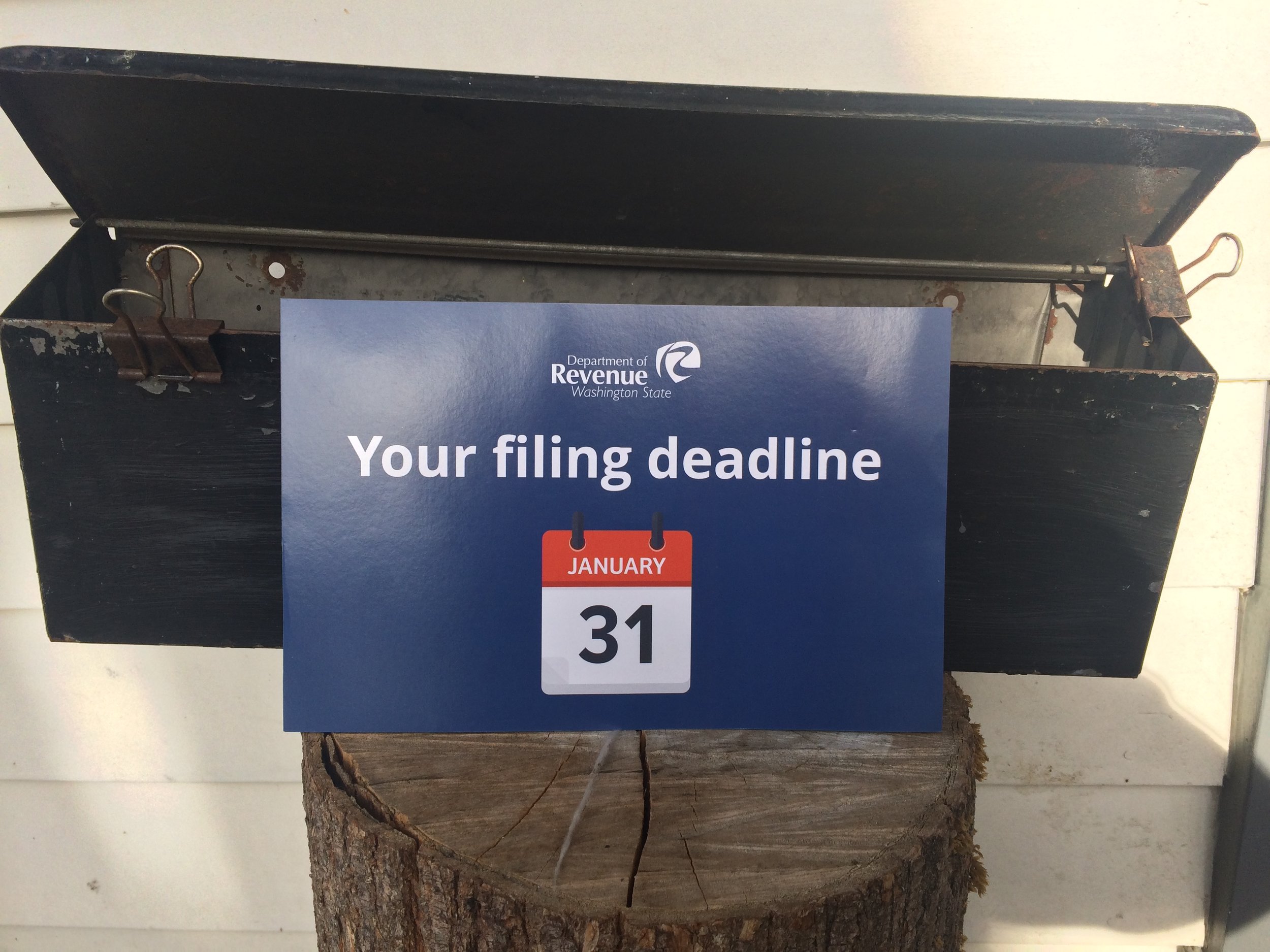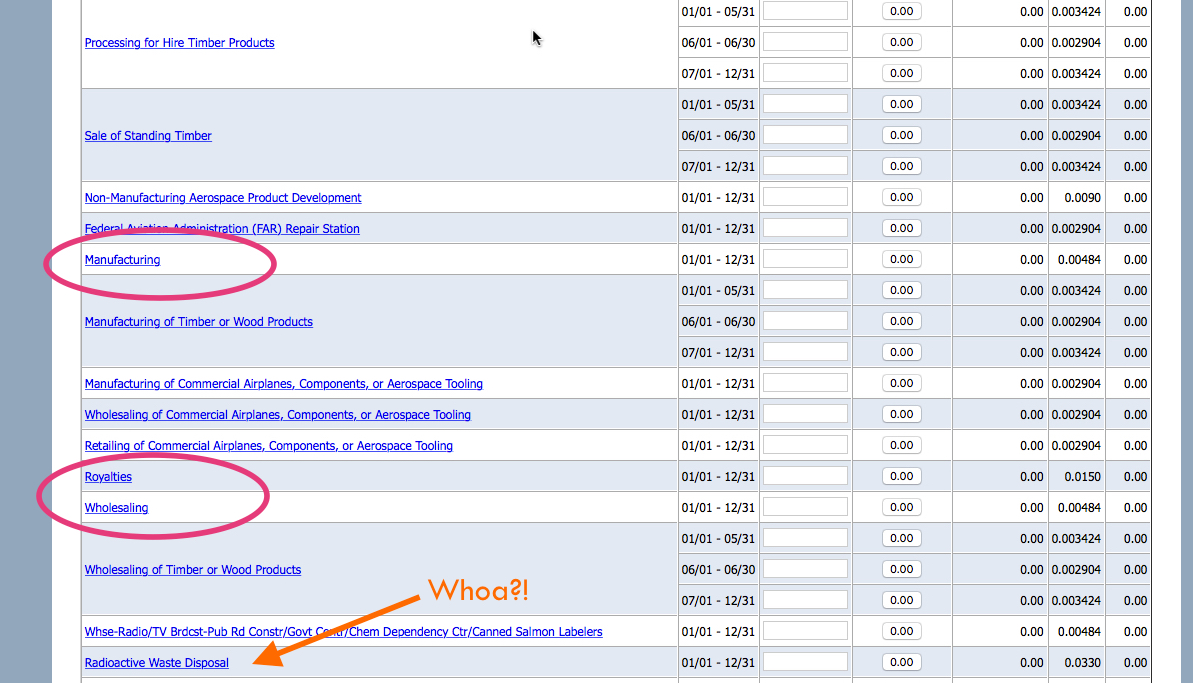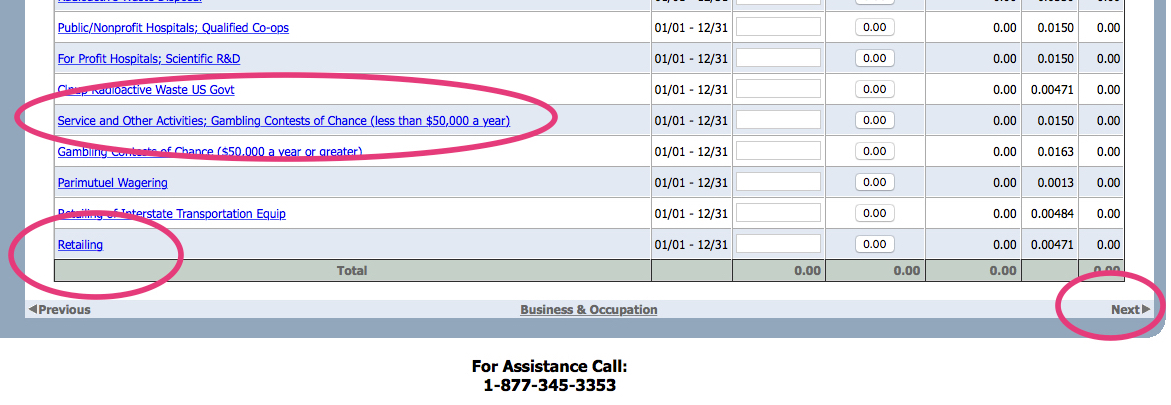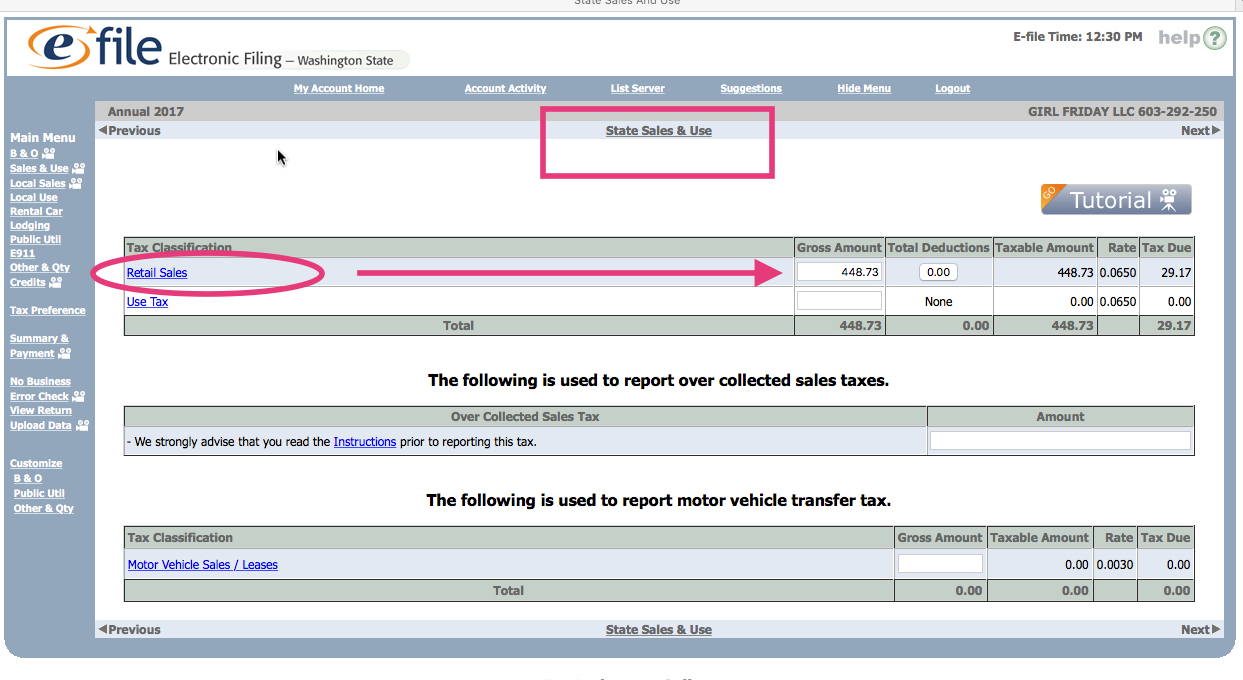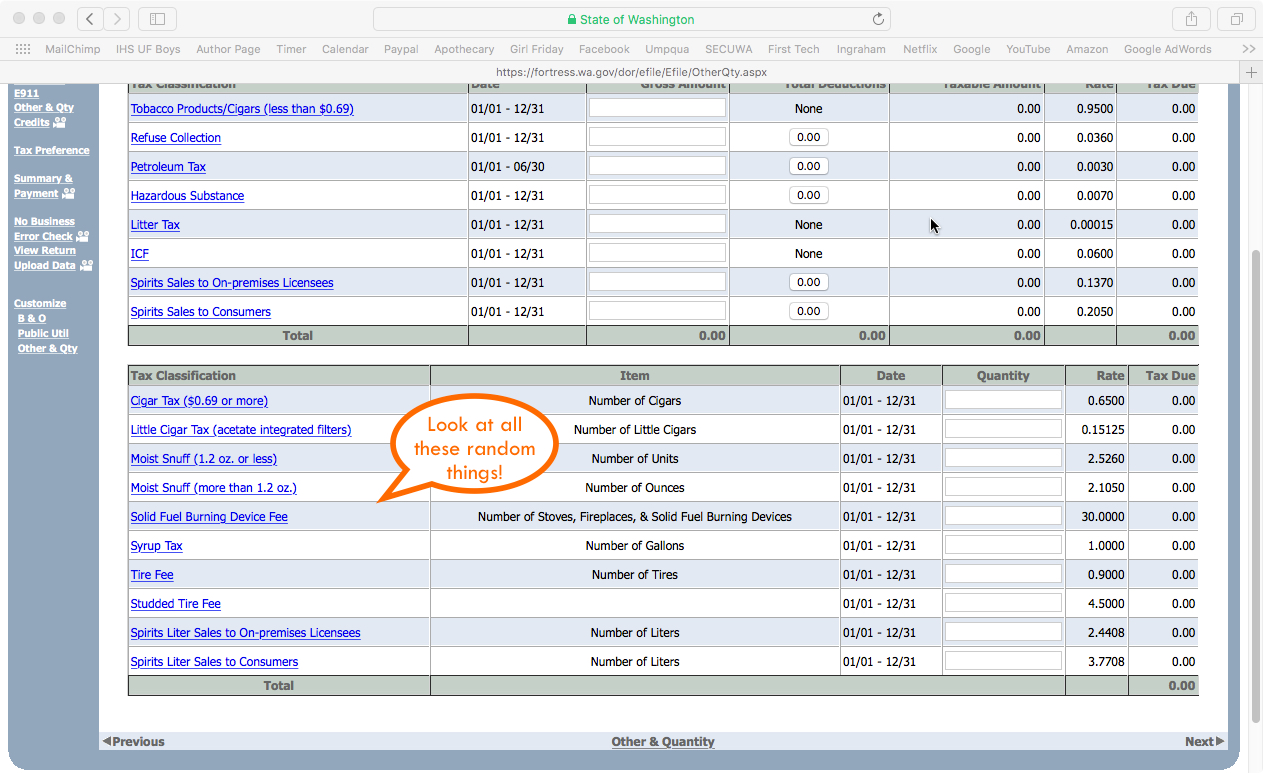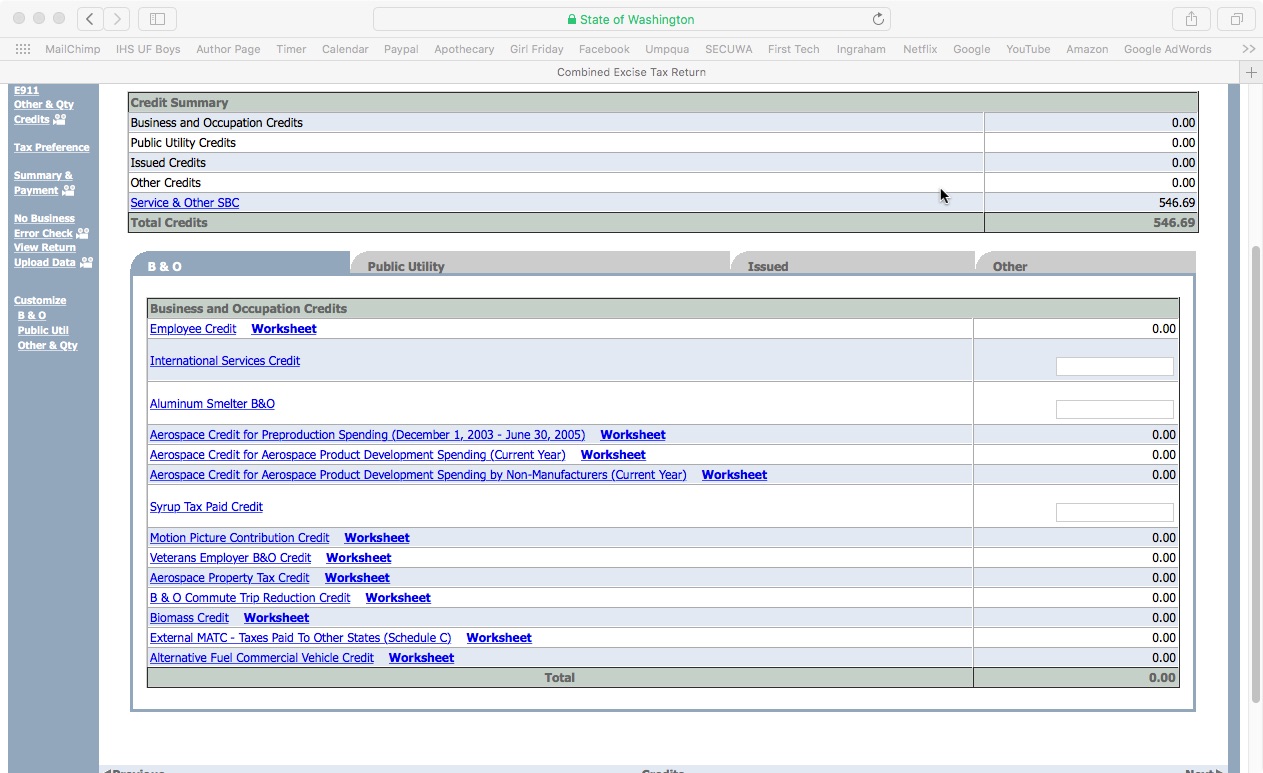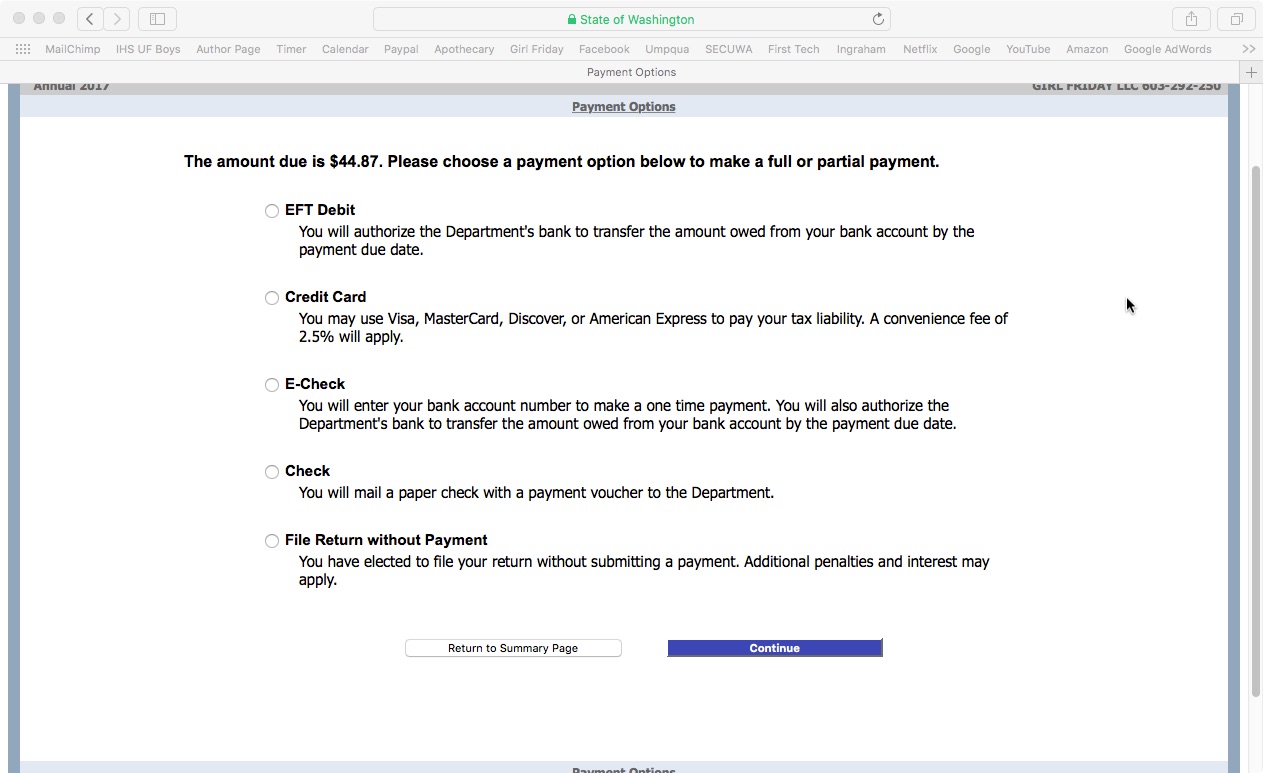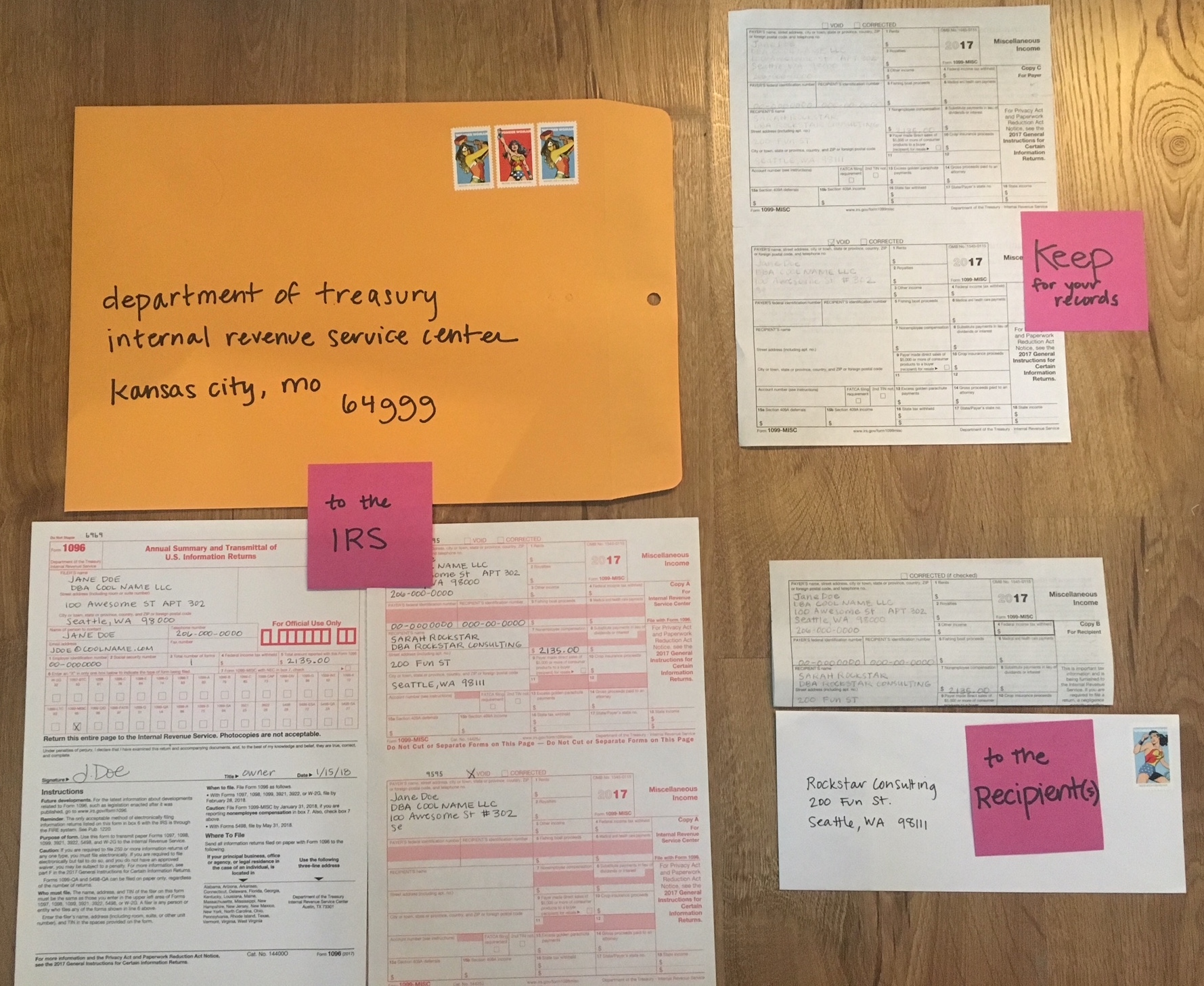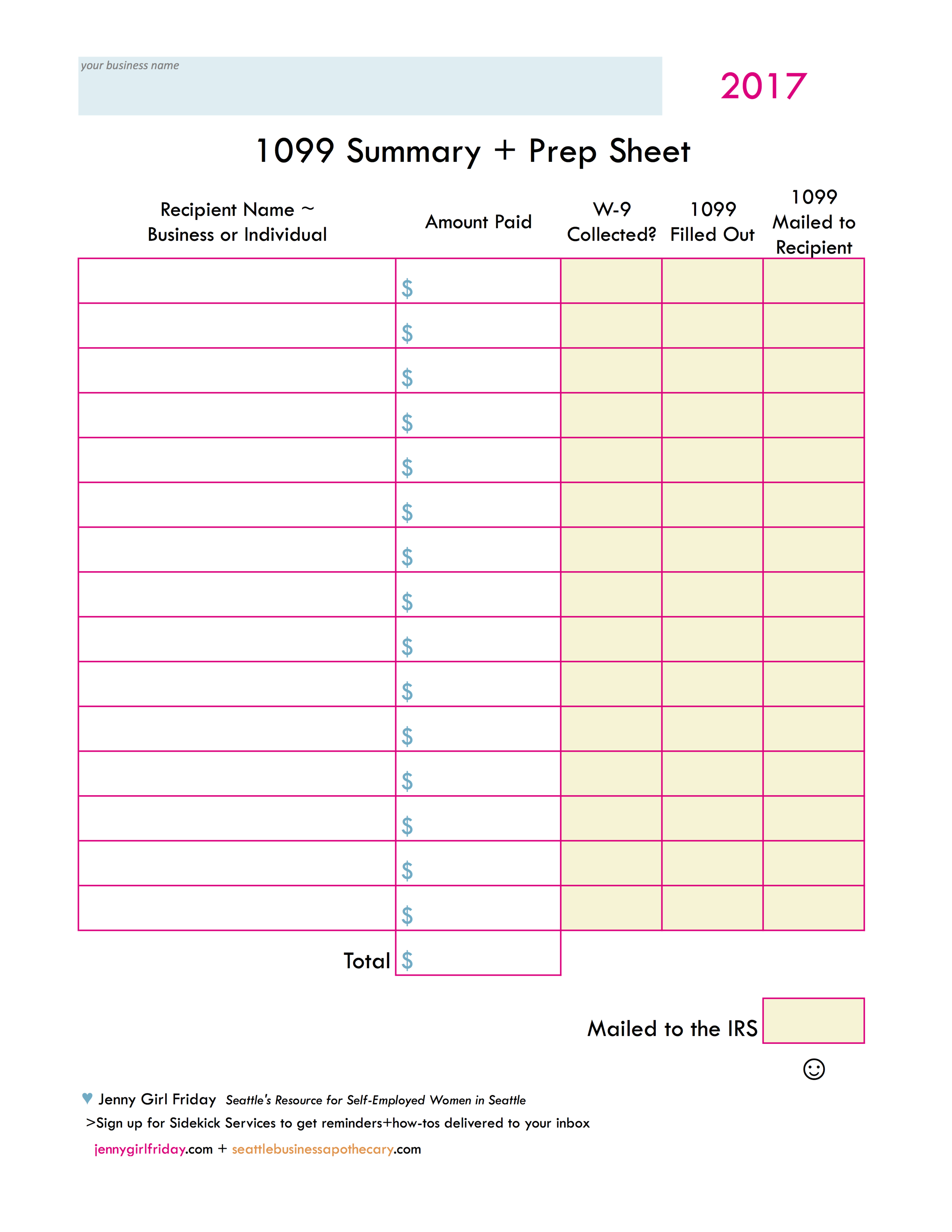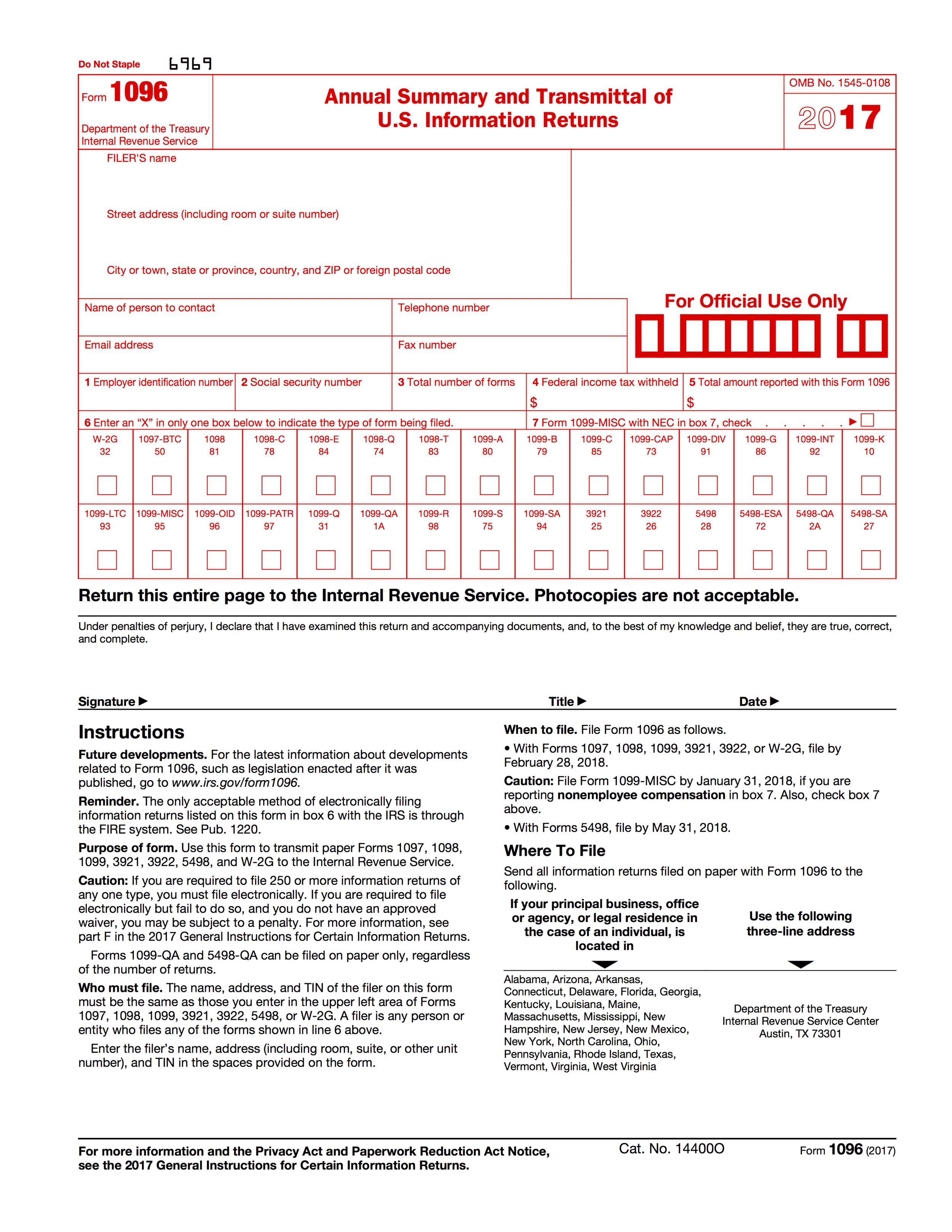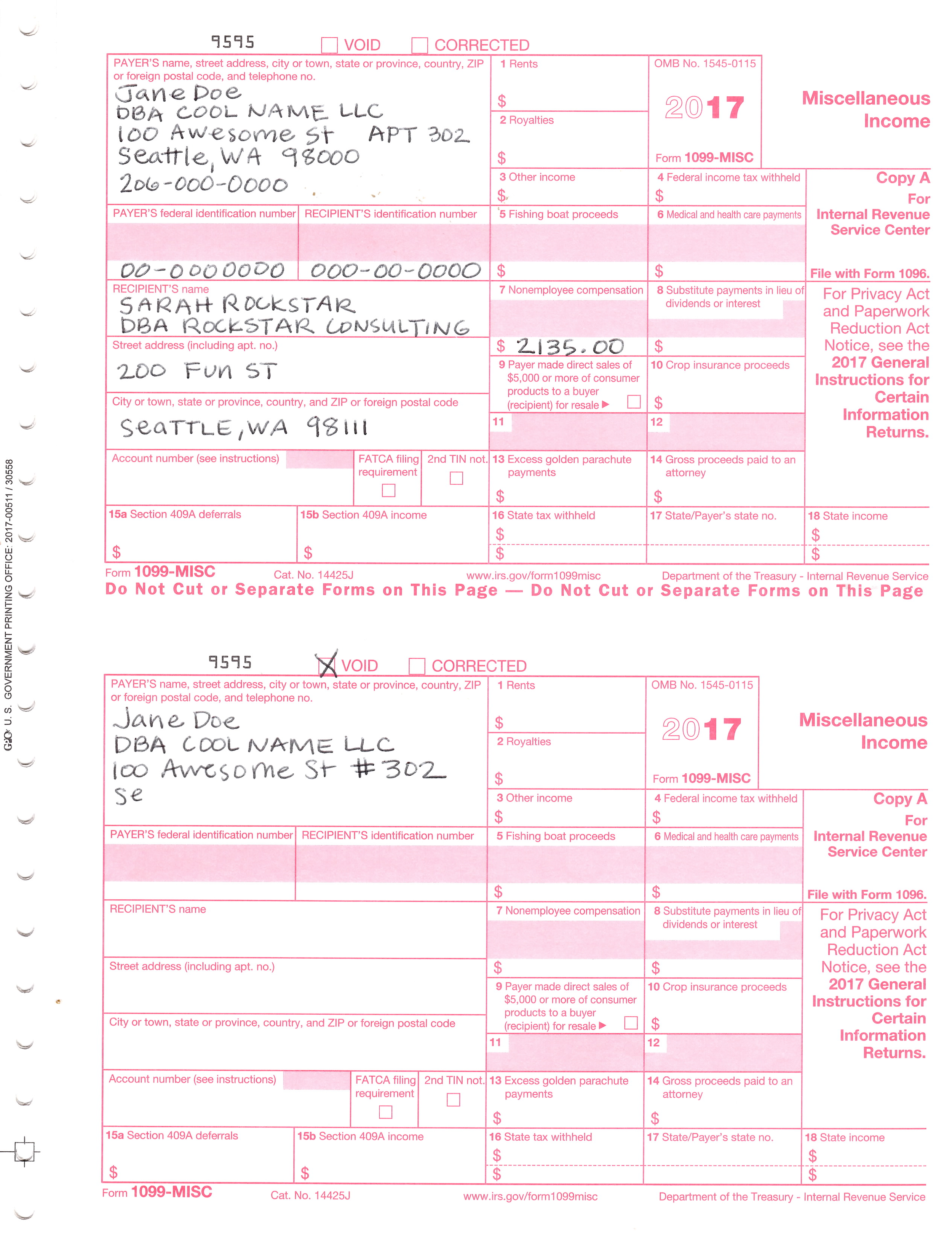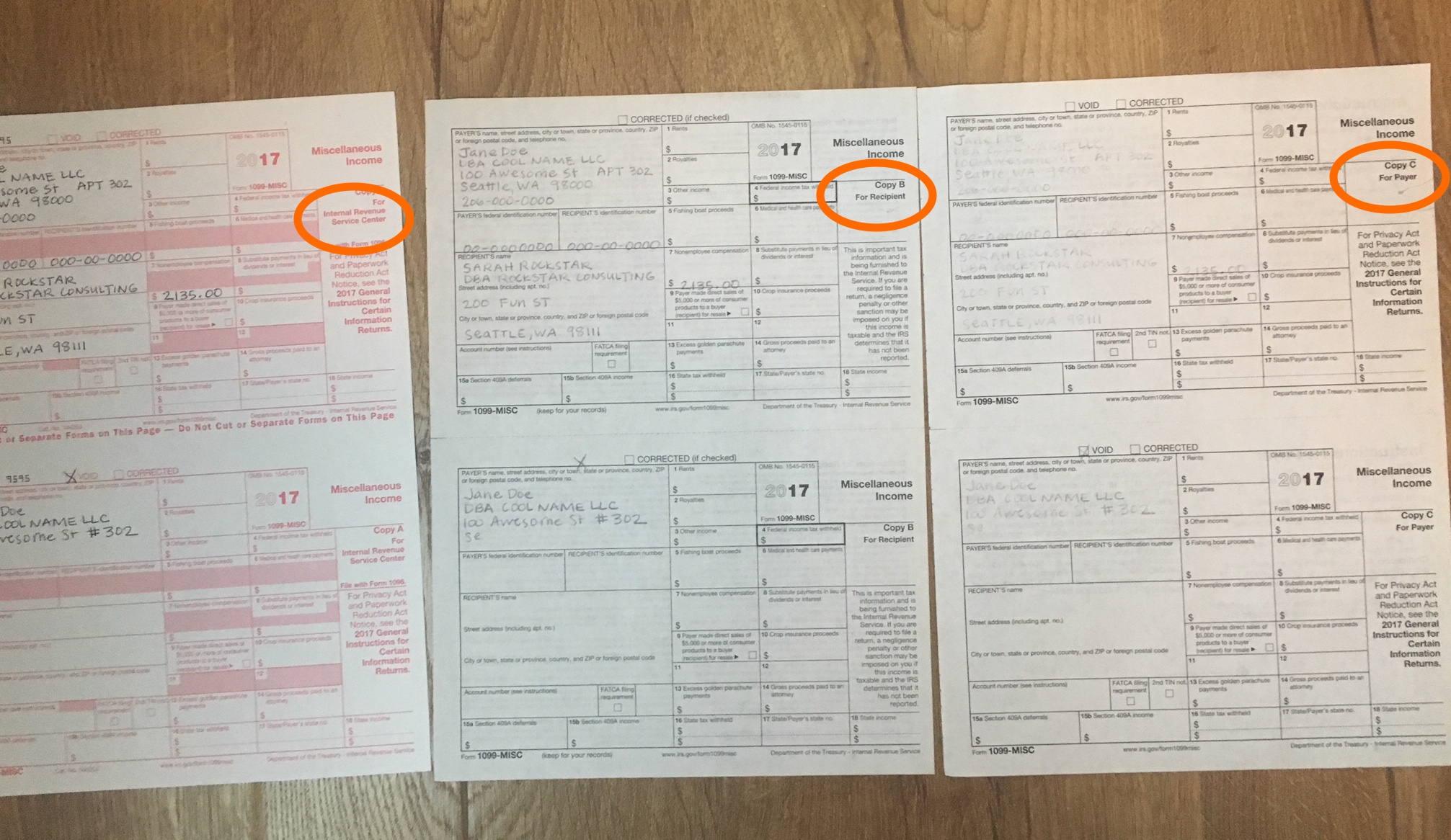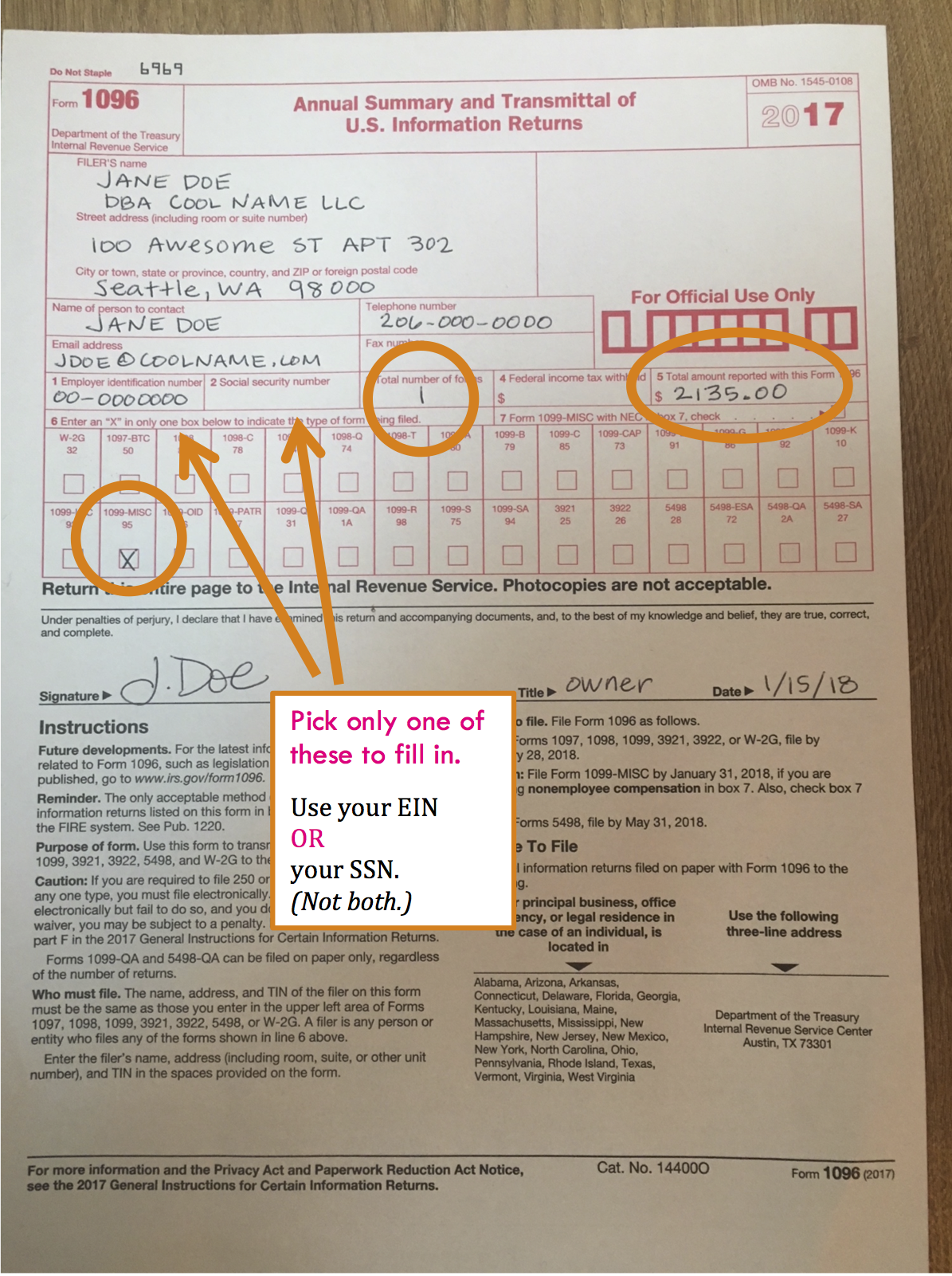WA state expanding who needs to collect sales tax
Washington state earns most of its money from sales tax. It requires businesses that sell products to collect sales tax.
It also requires certain services to collect sales tax. Often if these services are related to physical things, e.g. painting a mural on a wall, fixing a fence.
This is called Retail Service.
Now WA is adding more industries to the Retail Service category.
Which means new types of services will need to collect + submit sales tax.
Some new examples:
Advertising services
Graphic design
Presentations, workshops
Web design
Over the years, WA is constantly adjusting who needs to collect sales tax. Some people are not aware that technically their work is considered Retail or Retail Service.
You might not know …
That these services and products also need to collect sales tax:
Photography - services and photos
Selling digital products - newsletters, digital art, webinars
Painting murals
Repairing, improving furniture or other objects
Is this feeling scary or overwhelming?
Are you thinking things like…..
Oh Sh*t! I can’t afford to pay more taxes? Why am I burdened with this? Will clients think my prices are too high? This is not fair! I already hate number, now I have to do this?
I got you!
Here are some key things to know upfront
1 - This won’t cost you any extra money. This is tax that you collect from the customer, and sent on to the state. (Though it will take a little extra time.)
2 - Once you know what to do, it’s not that hard.
3 - Not sure where to start? Just add 10% sales tax to everything for now, you can get more precise later. Set that money aside in a separate account if possible.
4 - Our customers are used to paying sales tax, so hopefully, for most people, this will not be a big deal.
5 - When it’s time to file, the phone support at the WA Department of Revenue is usually really nice, and it is their job to help you. (You can also tag me in to help with a Quickie Consult-Call )
6 - Other people not as smart as you have figured it out, you can too!
I’ll be creating more support materials and resources in the future. In the mean time, feel free to hit me up for a Quickie Consult-Call for a small fee. Or, if you’re a new client, find me in a free 20-min Zoom chat.
You got this!
Once you’ve got your system, this is just one more way to feel like a Bo$$!
xo Jenny
Filing your BOI Report with FINCEN - a New Requirement for LLCs/PLLCs starting in 2024
UPDATE on 1.7.2025
This requirement is now paused. Here’s a quote from FINCEN:
In light of a recent federal court order, reporting companies are not currently required to file beneficial ownership information with FinCEN and are not subject to liability if they fail to do so while the order remains in force. However, reporting companies may continue to voluntarily submit beneficial ownership information reports. More information is available at https://www.fincen.gov/boi .
Check back with FINCEN, join the Sidekick Service Newsletter, or email me to stay tuned!
Here is the original blogpost, written in March 2024:
Hi there,
This is a new federal requirement - in 2024 - for anyone who has an LLC / PLLC.
Good news! It’s actually simple and quick and free.
It just looks kinda scary. (And some people in social media try to make it look scarier than it is to get your attention, and try to get money out of you.)
Short Story
You just have to log in, and provide the government with information about your LLC/PLLC and the people who own it. That’s it!
Some Details
The requirement includes filing a BOI Report. This stands for Beneficial Ownership Information. You might also see the acronym BOIR, where the R stands for Report.
If you registered your LLC/PLLC before January 1, 2024 … then you have all year to get it done! For you, it’s due by January 1, 2025
If you registered your LLC/PLLC this year, in 2024 … then you need to complete the BOIR within 90 days of registering your LLC/PLLC.
More of the Story
…Some people use LLCs to cover up criminal activity. So a branch called the Financial Crimes Enforcement Network (FINCEN) is tasked with getting info on all the LLCs/PLLCs and their owners, to verify legal activity. And look for the criminal activity.
Filing your BOIR
Get prepped:
It’s easy … you’ll just need:
The EIN for your business (or social security number if you don’t use an EIN)
A photo of your Driver’s License or Passport
The process takes 10-20 minutes. (More if you like to read, and re-read instructions!)
Links:
To File Online - Click here
For helpful walkthroughs and screenshots - Click here
ProTips
Question 16 looks a little confusing at first. They’re basically asking if your LLC/PLLC existed before January 1, 2024. If yes, they refer to it as an “Existing reporting company”. If you click Yes to this, you can skip a whole section.
There are little “Need help?” prompts throughout, with more information.
At the end, they’ll offer you a PDF of the report to download. BE SURE TO DOWNLOAD YOUR TRANSCRIPT! Currently, this is the only way to get confirmation that you filed. You’re not able to do it later….
And/or record somewhere that you finished your BOIR. Later this year, there will probably be lots of scary looking ads out there … and your system might get activated. Then, when you remember that you did this, you can feel calm and victorious.
Wishing you a quick and successful filing.
Considering getting a little reward for yourself for dealing with this pesky chore!
♡ Jenny
Thriving Plan for the Year Ahead
Rough Draft
Thriving takes cultivation!
And time!
And you are so worth it.
Ever feel like you're back in a hamster wheel with work? This is very common, as we try to please all our clients, families, friends...we can get stuck in a rut, so, so easily. It turns out, that loving your job, having things in balance, earning enough ... in other words, thriving, has to be cultivated. One strategy, is to set up an annual Thriving Plan.
Here's a tool for you to try out. (You might recognize it, it's revised from an earlier tool.)
Taking even 20-30 minutes to fill this out can make all the difference!
Start with the easiest boxes on the outside. Continue to fill them in to see what your priorities are for the year. Add any vacations, trips, retreats. Lastly, create your weekly schedule(s) and monthly routines - as a way to fit in all of your priorities.
Not sure what to write? Or trying to get it “perfect”. …Just guess! You can always change it later. There is great power in starting. And often, our gut-initial-instincts are what we really need/want.
First, I’ll share my example to give you an idea. Then, there are 4 different templates to choose from.
My Example
My biz year goes from Sep - Aug
Click on the image or the Option # to download.
Option 2
Year going from January - December
With 2 different weekly schedules - a and b
Option 1
Year going from January - December
With one type of weekly schedule
Option 4
Year going from September - August
With 2 type of weekly schedules
Option 3
Year going from September - August
With 1 type of weekly schedule
Wishing you some time in your schedule … to do this important work! I hope it feels fun and magical.
♡ Jenny
P.S. Want a little company or guidance with this? I’d love to help! I offer One-Time consults - and the goal is that they are game-changers. We can fill out your plan, talk through any roadblocks, highlight new desires, and whatever else you need to feel great about your job and life. Oh, and starting this year, you can bring a friend to the consult, and I can meet with both of you for the same price.
How do I know if I file ANNUALLY or QUARTERLY with WA state?
Quick Answers
Your filing schedule is assigned to you, after you register for a business license. Here are ways to find out your schedule.
Look for a letter you received from the Washington State Department of Revenue (DOR) - after you registered for your business license. It will tell you your schedule.
Call the DOR to ask them. They’re usually very friendly. It helps to have your UBI on hand, if you know where that is. (UBI is your WA state business number.) 360-705-6705
Log into your DOR account, navigate to Manage Returns, and see what it says there. If you’re on the Annual schedule, it will say that. If you’re quarterly or monthly, I believe it just shows the date that it’s due. So you can easily infer the schedule.
Some context and FAQs
Like all states, WA relies on taxes to fund programs. It collects all of these taxes through the Department of Revenue. There are two main categories. One, you’re already familiar with - sales tax. If your business provides any retail products or services, you’ll be required to collect and submit these taxes. The 2nd category is taxing businesses in a few different ways. The most common of these is Business and Occupation tax. These dollars help the state support and monitor businesses, to be safer for consumers, etc.
The state needs to collect its taxes on a regular basis. So, your filing schedule - annually, quarterly, monthly - is based on your projected taxes. If you’re going to earn a lot, and collect sales tax, then you’ll likely be put on a quarterly or monthly schedule.
If you earn less and/or are service only (no sales tax), then you’ll be put on an Annual schedule.
This is all based on your Gross Sales (all the money you collect from customers/clients … before business expenses). And, if you collect sales tax or not.
I heard that I have to send in Estimated Quarterly Tax Payments? Is this the same or different?
This is a super common question. This different. When you have a business, you must report to all levels of government: city, county, state, and the IRS. It's easy and reasonable to get them mixed up!
"Estimated quarterly tax payments" are part of paying your federal taxes to the IRS. These are estimated based off the profit your business is likely to make. They are due four times a year: Jan 15, Apr 15, Jun 15, Sep 15. Click here to read more.
If the state says that you must report quarterly, that is for state taxes, which include: B&O, sales tax, use tax. These are calculated from your actual sales.
I was assigned Quarterly payments. Ugh. Why is that? Can I change it?
Basically, the state wants to collect tax money on a regular basis. If you have a Retail business (meaning you'll be collecting sales tax) and/or if it looks like your income will be high, they will assign you to making reports quarterly.
♥ Please don't worry too much though! Once you know how to make reports to the state, it only takes a few minutes!
If you want to change it to reporting annually, in the past, the only way was to call the state in January. If your income is low enough, they'll make the change. That number is: 360-705-6705. It's possible that there are new rules, so you might try calling soon if you want to check.
You talk about Making Reports, Paying Taxes, Submitting Taxes, are these all the same thing?
Great question. They're slightly different. I like to think about things at the most basic level first. Once you have a business, you are required to Make Reports to the state. Sometimes, if you're very small, and/or do service work, then you won't owe any money. Yay! BUT, you still have to make the reports so the state knows this. This is step one of the process.
Paying taxes are when your business is actually being taxed. That's the B&O tax, and Use Tax. This is based off a percentage of your Gross Sales, and any purchases out of state. The money comes out of your pocket.
Submitting taxes is different. This is Sales Tax that you've collected from your buyers. It is tax based on their purchase. It comes from their pocket. You're simply the carrier of that money.
How can I get more info + help with this?
Lots of ways!
♥ Get help from the state DOR. They offer workshops, online tutorials, and even consulting! Click here to see more info at DOR.wa.gov.
♥ If you currently work with an accountant or bookkeeper, check with them.
♥ Get 1-on-1 help with Yours Truly. Sign up for a One-Time consult. We can work 1-on-1, or you can bring a friend to split the fee.
♥ Join me for Book$ Club! A monthly event, where self-employed folks gather to work on bookkeeping and biz chores - just like this one. In a Happy Hour setting. I provide 1-on-1 help, as time allows. And/or, you can ask other folks in the group. Like study hall, but more fun! Click to … Read More … or to Register
Estimated Quarterly Payments (EQ$) to the IRS / Just the Basics
The WHY behind EQ$
The IRS is a Pay-as-You-Go tax system. We're required to send in 4 estimated payments throughout the year ... then, it's True Up time when we actually file our taxes. If we overpaid, we'll get a refund. If we underpaid, we'll owe more.
Good news!
Once you know what you’re doing … it only takes about 5 minutes!
It can feel really satisfying, like you’re a BOSS of your business.
It makes Filing Taxes in April a lot nicer.
A Few Quick Facts about Sending in EQ$
When we send in an EQ$, it’s simply sending in money. It’s not filing taxes. There are no numbers to report. We just send money and make sure it’s attached to our name and tax ID.
If sending by check, there’s just a small voucher. If online, just a few fields to fill out to verify your identity.
You can send payments online, or via snail mail. Click here to read more.
IMPORTANT - if sending payments online, see note below.
It's fine to use your SSN with these payments. (Even if you have an EIN.)
The Due Dates are not even! (Weird, right?)
DUE Dates
April 15
June 15
September 15
January 15
Note - When these dates fall on the weekend or holiday, they will shift to the following business day.
To Send in or Not Send In….
If total tax for the year (related to your biz profit) is $2000 or less, then the IRS says that we do NOT need to send in payments.
If total tax for the year (related to your biz profit) is $2000 or more ... we're required to send in payments.
If we send in partial payments, or none at all, we might have to pay a penalty. Usually these are a few hundred dollars or less.
How Much to Send
The IRS offers a complex way to calculate your EQ$. I offer simpler alternatives. Three different methods to choose from. Click here for the NEW worksheet with instructions.
IMPORTANT NOTE / If Paying Online
IF you pay online, and use a 3rd party, be sure to choose "Personal Taxes"
Why? Because your business does NOT pay taxes, you pay personal taxes on the income you earned through your business....
Well those are all the basics on EQ$. It might feel intimidating at first … but it really gets easier over time!
How to do a Retreat / Worksheets V.2
ROUGH DRAFT
I'm a huge fan of retreats!
Especially in the summer.
Yes, it's true ... it can feel super difficult to find the time, space, and money. And yes, it's true, it can feel indulgent. And bring up weird/uncomfortable feelings. (I feel guilty. Am I allowed to do this? Why am I so tired? Why am I sad, when this is supposed to be fun?)
Also, retreats pay off - both for you, to feel better. And for your business.
Also, you are worth it.
You are the talent, you need support.
You are the leader of your business, you need space for inspiration and setting the next direction.
You are the manager of your talent, you need strategies to stay in alignment with your vision.
We spend most of our time during the year meeting other people's needs.
This is the time of year to tune into your needs.
And then, to adjust the business to make it a more ideal job for you AND to offer more value for your clients/customers.
I believe it's essential to both you as a person, and the success of your business!
(Also, you can write-off the cost / it's a business deduction.)
♥
Interested in setting one up for yourself?
Check out these worksheets below. They are all in BETA form.
Read this one first - How to Do a Personal/Professional Retreat
Then program Options:
Taking Stock
Rest / Fill the Reserves
Intuition
Inspiration
New Skill
Focused Work
Debrief/Reflect on a specific experience or chapter.
Do you know any great Accountants or Bookkeepers?
This is a great question. Also, it is the #1 question I receive through email … so I decided to keep a full answer here for you - that I can update regularly.
Short answer - Yes! I know some amazing folks.
Longer answer - They are often booked. Below is my current list of people I know, and others recommended to me. If none of these folks work out, read some tips for searching for your own tax/money pro - at the bottom of this post.
Note: If you’re a Therapist - please see this list, specially collected for you.
/ / / / /
One last note: If you end up hiring one of these amazing folks, please consider coming back, and leaving a Tip in the Tip Jar. It took me years and hours+hours to find these good people. Thank you!
Valerie Moseley, CPA
valeriemoseleycpa.com
Available for consults: self-employed, S-corps, interesting tax situations, etc.
Limited openings for perfect-fit clients
Jocelyn Muhl, CPA
northseattleaccountant.com
Accounting services include time for questions
Available for consults, and perfect-fit clients
Kathy Coggins
cogginsaccounting.com
Kathy loves to work with S-Corps!
She has a full team to support you with other services too, like payroll, bookkeeping
Luke and Amy Weissgarber
ltwcpa.com/
Based in Bellevue, just moved up from Texas. Recommended by trusted CPA, actively looking for clients.
Julia Ensign
ensign-bookkeeping.com
Bookkeeping services for local businesses
Friendly! Offers phone call to take about working together
Patty Kelley, CPA and Katherine Griswold, MBA
portumbooks.com
Taking new clients, focus on small business. Offering full bookkeeping services, preparing documents for taxes, consulting, Quickbooks advising, and more!
Lindsey Gaughn, CPA
gaughanlindsey@gmail.com
Available for consults, bookkeeping and accounting services
Email to get in touch
Hipster Money / Alexandra Perwin, CPA
hipstermoney.com
Usually booked … sometimes available for consults, new clients who are perfect-fit
Clear Sky Money Matters / Emily Zillig
emilyzillig.com
Bookkeeping, money coaching
Sadie Frederick / Bookkeeper
sadieaccounts.com
Specializing in small Seattle nonprofit clients (also a long-time client of mine)
Justin Bourn, CPA
wzbcpa.com/team/justin-a-bourn/
A client said he’s friendly and easy to work with. Now the co-owner of this company. I hope to meet him some time.
♥
Tips for finding your own Tax/Money Pro
Keep asking everyone you know, to get a list of names 3-5 or more if possible
Try to meet at least 2-3 - for some type of initial consult. You will learn a little bit each time, and you’ll get a sense of the various communication styles. And what you like and don’t like.
Keep in mind - this is an equal power situation. You are the client, you’re an expert on your biz and your personality and work style. They are the expert of filing taxes and numbers. Be sure it feels good to talk with them and work with them.
If you want someone who will teach you things, ask them specifically if they like explaining how taxes and bookkeeping work.
For Accountants, be sure to ask if they file city and state taxes too! Many accountants do not.
Good luck with your search! … and please do let me know if you find any great people to add to this list.
Jenny Girl Friday
Weekly Staff Support / Check-in Meeting (For being happier at work)
Here’s my latest tool and practice for being happier at work: Weekly Staff Support Check-in Meetings.
In a nutshell
The idea is to look at the week ahead, and to ask myself, What support do I need to get everything done, and feel great?
Context and Guiding Ideas
It’s easy to move through the days and weeks, working constantly, to complete all of the things on our to-do list. Showing up for clients, finishing projects, handle business chores, etc. We are often driven by due dates. And many of us do whatever it takes to fulfill those commitments. We use the tools of: fit-stuff-in, dig-deep, work-until-it’s-done.
That’s cool, and gets results. …though, after a while, it can be very wearing on the mind, body, and spirit.
Here’s what we forget - how to give ourselves support to get through these big lists of work. Support can range from: getting tools we need, creating more time and space, gatekeeping small things out, taking things off the calendar, fuel or nourishment, ideal working conditions, encouragement, company … the list goes on. It’s whatever you need to get things done (and not be depleted).
Enter the Weekly Staff Support Check-in Meeting
You invite your two selves, the Boss You and the Talent You, hence the “meeting” part.
Talent You can write out all of the things on your plate. And then shares (with the Boss You): here’s how I’m feeling, here’s what I need, here’s what I wish. Then, the Boss You can make some decisions and provide support. After all Boss You wants to keep the Talent in the business!
Here’s how to use it
1 - Write some notes in the calendar section. Perhaps put in critical meetings, periods for working, breaks.
2 - Fill in the 2nd row - looking at tasks on your mind or list. Perhaps assign some to the calendar above.
3 - Make some observations. What do you notice - thoughts, feelings?
4 - Drill down - What’s a theme? What energy is needed? What support do I need? Perhaps add - how you want to feel at the end of the week?
5 - With all of that in mind, define some specific staff support. And then, make plans to give it to yourself.
The Quickie Version
At the beginning of your work week ……. let your eyes glaze over your calendar and to-do list.
Then, ask, “What’s one thing I can do or give myself to move through the week, get things done, and feel great?”
Channel the idea that you want to be the best boss in the world.
Give it a whirl, and let me know what you think!
: ) Jenny Girl Friday
Sidekick Services / Paid Newsletter FAQs
How many newsletters will I get?
12 - 20 each year.
One, at the beginning of each month, with the important due dates, helpful links, and tools. Sometimes, you may receive an extra newsletter, if it pertains to a timely + specific topic. For instance, opportunities - like the PPP Loan, or if there are important changes with tax + licensing rules or procedures.
What will be included, specifically?
Reminders for Due Dates - for taxes, license renewal, and LLC / PLLC renewal.
Links to how-to articles, walkthroughs, or information.
Handy tools + worksheets to make biz chores easier.
AndPlanned for 2022: more tools for tending your Money Garden and being Happy at Work.
Topics cover:
IRS Taxes - Filing and Prep
Sending in Estimated Quarterly Payments to the IRS
WA State Taxes
King County Taxes
Seattle Taxes
+
Renewing PLLC / LLC
Renewing Seattle License
+ More
What does the newsletter cost?
There is a monthly fee for the newsletter. You can choose what you’d like to pay, based on your situation and how you feel. Suggested prices:
$15 - I’m new to business / on a strict budget
$20 - I want to pay the Suggested amount
$25 - I’m thriving and want to send some love back your way
$26+ (custom amount) - You have saved my life! I want to show a huge gratitude!
How many months is something due?
5 - 9 months, depending on your situation.
If you file Annually with WA State, you’ll have things due 5 - 7 months out of the year.
If you file Quarterly with WA State, you’ll have things due 7 - 9 months out of the year.
Why am I paying you monthly, if some months there is nothing due?
Three Reasons:
1 ) It’s helpful to know when nothing is due, so you can have peace of mind.
2 ) Some months you’ll be receiving a LOT of content and forms. Others are very light. Your monthly fee reflects the average value.
3) Providing regular payments, helps me to be building materials for you year-round.
Also, the months in between are a great time to rest from biz chores, to refine systems, or to work on being Happier in your job. Sometimes I will provide tools or articles related to this other work.
Is there a bonus for signing up?
Currently … there is no bonus for signing up.
If I develop one in the future, I’ll send it to all the subscribers first!
What if I no longer wish to receive Sidekick Services, but want to know about classes, workshops and other services?
I have a new Announcement List. It’s free to join. I will share about any new workshops, classes, books, and openings available for Friendly Tax/License Consults. (FYI - These announcements will go out first to Sidekick Services.)
Do I need to join the Announcement list as well?
The simple answer - No.
Why? If you are on Sidekick Services, you’ll receive all Announcements. And, you’ll receive them first! The Announcement List is a great option if you decide to leave Sidekick Services.
Is this useful if I live outside of Seattle?
Many readers have shared … that Yes! It’s still helpful if you live outside of Seattle.
For two reasons:
1 ) You get supported for IRS tax prep and filing, relevant to anyone working in the U.S.
2 ) The reminders about local taxes (city, county, state) often prompt readers to get in touch with their own local agencies to find out what is due.
Will it be different, now that we’re paying for it?
At first, not really. Eventually……….Yes!
With your support, I’m planning to up-level both the Sidekick Services and the Business Apothecary. But, it will take some time + money.
Hopefully, you will someday see:
New design of the newsletter
Additional and redesigned tax + money tools
Updated how-tos and walkthroughs
A web re-design for the Apothecary
+ More!
Why did you switch to a Paid Newsletter … when you said earlier that you wanted to keep it free?
I really, really wanted to keep it free, modeling after NPR or Wikipedia. Over time, I learned that it wasn’t sustainable. I had a few donors (thank you!), which was encouraging and so helpful. Also, it was only just enough to cover tech costs and provide a tiny bonus.
Over time, I realized the following foundational ideas:
To fully develop the newsletter and tools, and to really serve you all abundantly, I need 1 - 3 days a month for writing and design.
NPR and Wikipedia have regular fundraising campaigns. I didn’t want to start inundating you with those kinds of messages! I’m a fan of only sending need-to-know stuff to you and your inboxes.
The value of what I’m providing is designed to save you $500 - $1500 a year or more + intangibles like less stress, more peace, empowerment. And this is worth charging for.
Anyone desiring to thrive in self-employment can afford this monthly fee.
This model will be like Spotify, Hulu, G-Suite. It’s something you want or need, and it costs money.
Is this a Business Deduction for IRS taxes?
Yes! I would suggest putting this under “Supplies”.
What is Memberful?
It is the company that will process your payments, and keep the subscriber list updated. Whenever you’re changing your payment information, updating a credit card, or canceling, it will be through Memberful.
What if I want to cancel?
You can cancel any time, through Memberful. If you’re not sure how, please email me at jennygirlfriday@gmail.com, and I can do it for you. (Please allow 5 - 10 days, if you cancel through me.)
What if I want to change my monthly amount?
Stay tuned … I will find an answer and report back. And/or email me at jennygirlfriday@gmail.com, and I’ll see how to do this for you. (Please allow 5 - 10 days, if you are requesting a change through me.)
This service has been a game-changer for me. What can I do to show appreciation?
Thank you so much! I’m thrilled to hear it! All of the following are welcome: sending me a note in email, leaving a little Love in the Tip Jar, increasing your monthly fee, and/or encouraging friends to sign up. Thank you again! It’s my goal to help you THRIVE and it’s such a joy to know when things are working for you!
King County Taxes - FAQs
What does the County tax us on? How much are the taxes?
The county taxes us on property:
1 - real estate (land and buildings)
2 - "personal property" (equipment)
If your business owns any land or buildings, please contact them directly.
For "personal property", totaling OVER $7500, we pay about 1% in taxes. (We owe nothing if the value is under $7500.)
Do I have to report to King County?
Technically speaking, ALL businesses must register with King County and make a report every year. Realistically speaking, many micro and small businesses do not know about the County, and are not registered, and it has not been a problem (so far). One similar situation is the Speed Limit. Many people drive over the speed limit, but never get a ticket—especially if you're over by only 2-5 mph. I cannot give any advice about what to do, but want to give you some context so you can make your own decision!
What counts as "personal property"?
"Personal property" is a funny term. It sounds like the opposite of business! But it IS the term for equipment and supplies that you use to do business. Like: desk, shelves, computer, printer, art equipment, and even office supplies. Think of it like this: it's property that we can pick up and carry, on our person.
How do I register with the county?
Someday, I'll have a blog post on this...for now.......)
There is a form to fill out, either on paper or as an interactive PDF.
To find it~
1
Go to the eListing page
2
Look on the LEFT side Navigation
3
Click the "Report New Business" button
4
It will download a Word document
5
It asks you to list "Owned Business Assets" ~ these are all the physical things your business owns (furniture, tools, computer) that do NOT get consumed.
6
Notice, right underneath the the "Owned Business Assets" subtitle, there's a small box where you need to list "Supplies Monthly Cost". This is for things like paper and ink, things you use up.
7
Send in form—either through email or snail mail.
Call the County with any questions! 206-296-5126
What happens after I register?
The county will add you to their system, and will most likely send you an email. Then, the following calendar year, you report any additional equipment the business has acquired, and/or any increases in supplies.
IF the total exceeds $7500, the business will be taxed about about 1%.
IF there's NO CHANGE, then we're still required to send in a report saying so.
How do I make a report to King County?
Go the eListing on the King County page.
If you need help, you can reach the County by phone or email. Don't be shy, it's their job! Here's a quote from the website:
"DID YOU KNOW?The assessor's staff is available to assist you in any way we can. If you have question or concerns, please feel free to call us at 206-296-5126."
43 Ways to Work On Your Business - When you have Unexpected Free Time
ROUGH DRAFT - inspired by the Coronavirus.
Have some unexpected Free Time? Want to get something done on your business, but not sure what to do? No problem! Read on to see a Master List of ways to work on your business, plus some strategies below.
Why do I need a list you ask? Because…once you sit down to ponder the free time, and what to do, it’s easy to draw a blank or get distracted. Next challenge, once you do start thinking, it can be overwhelming. “I need to update my website, order business cards, work on bookkeeping…which one do I do?”. This brings up one of our biggest enemies, Decision Fatigue,…we don’t know which to choose, so we go back to Facebook, email, or wondering around aimlessly. All of those are fine, except when we’re trying to make progress on something.
Free time is your opportunity to work on things that are Important but not critical. These important tasks are the keys to making your future life easier.
Below is a big list. First, here are my suggestions for working with it.
Jar
Print out the PDF version of the list. Cut out the options. Throw away the ones you don’t like. Put the ones you like in a jar. When you have free time, pull out a slip of paper. If it sounds helpful, doable in the moment, get to work. Don’t like it? Pull out another. Keep repeating until you do.
Top Ten List
Pick ten of these tasks. Put on a list. Each time you have some unexpected time, look at the list. Pick the easiest one.
Two-DO List
Look at the list. Pick two tasks. Write somewhere visible. On post-its on computer, on calendar, on your fridge. Whenever you’ve got time, work on one of them. When you have time again, work on the other. Repeat.
Roll some Dice
Use an online dice roller. Or, find 3 - 5 dice. Roll one die to determine how may dice to roll. Now, roll the dice, pick the item on the list with that number. Do that task. Don’t like it? Go again. Still don’t like it? Look over the list and pick one.
Current Master List - A work in progress.
1 - Review your website.
Just read everything first. Go back through, make a few changes as you go. If needed, make a list of future updates and changes.
2 - Update pictures.
Upload new ones, or make appointment in the future with photographer.
3 - Get a head start on taxes.
If you’re not sure what to do, read this post: How to Prep for IRS Taxes
4 - Do some business analysis.
Look at each quarter / year. Figure out profits for each, types of clients and work offered. Make some predictions for the future. Record any changes to make.
5 - Mini Retreat – Big Picture View
For options, read this post: How to do a Mini Retreat - Business or Personal
6 - Time planning – weekly schedule, monthly, year.
Print out worksheets or make your own. (Click for Weekly Flow, Year -at-a-Glance.) Start with a clean slate. Add in required activities. Look for things to cut. Add in top priority activities.
7 - Update LinkedIn profile.
8 - Review all digital presence.
Make adjustments if needed.
9 - Get ahead on newsletter, Insta posting, other social media.
10 - Digital clutter clear out.
Look through computer files. Delete old items. Adjust folders as you go. Archive old files.
11 - Paper work and files.
Go through paperwork. Look through everything to pull out old documents to recycle/shred.
12 - Bookshelves.
Pull all the books down, dust. Look through them. Give away old books. Perhaps stack in a new way.
13 - Bulletin board / vision board.
Make a new one, or re-do current ones and start a new one.
14 - Visual Reminders
Make posters for the office or fridge – with whatever you need to be reminded of – routines, goals, plans, schedule.
15 - Self-care plan review.
What are you currently doing for self-care? What do you wish to add? Anything to cut? What’s your budget? Make adjustments and add activities into your schedule.
16 - 3 Ideal Clients
Check out this post - Three Ideal Clients - Book Excerpt
17 - Review policies.
Adjust or add.
18 - Update Terms / Contract.
19 - Look at prices and adjust.
Perhaps add new fees, e.g. travel, late fee, reschedule, rush work.
20 - Development new offering or class.
21 - Brainstorm new marketing materials.
22 - Create Pinterest board.
For inspiration/ communication with designer, or to draw from yourself.
23 - Research people to hire / network with.
24 - Organize photos and imagery for marketing.
Update labels, perhaps put in one folder.
25 - Collect a copy of all your materials and put in one place.
For example, all ads or brochures, business cards – put in a notebook. Or all of your handouts, print and put in a folder / notebook.
26 - Take inventory of supplies.
Reorganize supplies. Label.
27 - Make a bingo card of goals. - See below.
Pick 5 categories. Write in the spaces under the BINGO. Under each, fill in tasks or accomplishments. Give yourself rewards when you get a line or blackout. I used this for marketing my book after it was written. It’s still on my fridge!
28 - Get all tax + legal info in one place.
Online and in print form.
29 - Research swag you might want to make.
30 - Research boutiques, galleries.
31 - Research events in the area for small business / community / your field.
Make a calendar of when they happen.
32 - Research events you might want to sponsor.
33 - Research charities / causes to give money or time to.
34 - Reach out to old friends and contacts just to say hi.
Only if this feels legit and you want to, with no direct business agenda.
35 - Follow up with people you’ve talked about collaborating with.
36 - Create a class or workshop to offer for profit, or as a volunteer.
37 - Do a numbers review, by month.
Check out these worksheets: Service Providers, No Sales Tax; Services Providers, with Sales Tax; Product Makers (Retail/Combo).
38 - Make a list of Household Bills
This can be useful when making your own Salary goals. Click here for a worksheet.
39 - Give yourself a Reward.
Because you deserve it. Click to see a menu.
40 - Find some books to read, related to your work.
Consider going to the bookstore to be able to browse in person.
41 - Research a vacation or work trip.
Put it on your calendar.
42 - Do some math to give yourself a raise!
Update on website and materials.
43 - Send an email or thank you card to a role model or someone who inspired you.
Okay, that’s the big list. You don’t need to do all these things! It’s just a menu. Use one of the strategies above to make your own plan. Either the Jar, Top Ten, Two-DO list, or Roll the Dice.
♥
Please, let us know how it goes! Share any stories or suggestions in the comments below.
Cheers,
Jenny
Click on the image to get a downloadable pdf.
Here’s the Bingo Card I made after publishing my book. It helped me stay on track and celebrate successes!
What's Your Tax Prep Style?
Dear Readers, this is an evolving blog post. I’d love to get your feedback on which terms / descriptions work or don’t work for you!
Work with your nature.
This is one of my favorite guiding principles. And it's more important than ever when it comes to chores or anything that feels tedious, new, overwhelming.
What style fits you? ....when it comes to working on IRS tax prep?
(Nicknames are works in progress.)
♥ The truth?: I ignore it until the last minute, then scramble and get it all done. (Phoenix)
♥ I like to start as early as possible. In fact, I already have! I work steadily until the job is done finished. (Early bird)
♥ I do best breaking up a task. I prefer to work over several sessions. (Marathoner)
♥ I like to do the job all at once, on a planned day. (Personal work party)
♥ None of these fit exactly/I'm a mixture. (4 Leaf Clover)
The idea: choose your style. Name it. Claim it. Plan for it. Be at peace with it. Below are a few ideas for each style.
P.S. If you're new to this, I suggest reading the Marathoner description as well as your style.
♥
Phoenix
Do your thing! No reason to fix something that works. When the time comes, find this email and these tools to offer some help: All-at-once Prep + CalculateBasic. If needed, here's an article if you get stuck somewhere. Perhaps, mark off a day or two around 4/12, 4/13, 4/14 to do the work. Lastly, if you can, clear your calendar on 4/15 or 4/16 to take a break, go to the spa or drive out of town to reward yourself and recover. (I'm keeping this short, because your mind is busy with other things right now. You'll get to this later.)
♥
Early Bird
This message to you might be too late because you're probably finished. In case I caught you in time, here's an article that outlines the whole process. And a worksheet to capture all your numbers: CalculateBasic. You'd probably like to fill out this second sheet as well: Calculate Next Level. Before you get too far, please be sure to choose a reward for yourself. Set aside some money for it and plan whatever time it takes. Yes, you start early because it's your nature, there's an urge to. That's cool. Still, let's reinforce and reward that nature! We want to keep you happy in your job. If you feel a bit guilty, then it's probably the right amount.
Oh, and here's an article on filing options. As you know, it feels so good to get the appointment for the actual filing on the calendar, whether it's meeting your accountant, filing yourself online, etc. Heads up, there are a few changes this year! A new 1040 and a few new rules. I'll be sharing about that soon. I'm just mentioning it so you plan in a little extra time. If you'd like to dive into research now, here are the 1040 Instructions, start on page 6.
♥
Marathoner
Slow and steady wins the race! And, "Life ain't a track meet, it's a marathon." Ice Cube. You know that working slowly over time means less impact on your life, the pain can be spread out. If you've done this before, you've probably got a system already. If you're new / as a reminder to experienced folks: plan several work periods over the next 4 - 6 weeks. Prep time really ranges from 2 hours to 12 or more. Just take your best guess and plan in the time. You can pick a regular day + time, like "Fridays from 1 - 3pm", or choose a time block like "1 hour" to fit into your weekly schedule.
One option is for you to follow along with the Sidekick Service Tax Prep series coming out soon. I've broken the process into 6-7 steps, and will send an email about each one...so you can follow along with me. If you'd like to space it out yourself, take a look at this article, with worksheets for each step. Or, look at this All-at-Once Prep Sheet to plan your own sessions. I also suggest choose a little treat for each work session and a big Reward for when you're all finished.
♥
Work-Party Girl
You like to get in the zone; to give this task your whole attention, all at once. Like gearing up for party or 5K, you want to collect all your tools and resources, create the space, and get it done, and done well, and then shut the door and be finished. Tips for you (if you're new/need reminders): schedule three days on your calendar: 1- Personal Tax Work Party, 2- Time OFF to recover/reward yourself, 3 - Follow-up Tasks.
Create a space in your house to collect all of the things you'll need. Tax documents coming in the mail, bank statements, receipts, etc. Perhaps print out this sheet Collect Stuff. You can use it to slowly collect items prior to your Party day, or, do it first thing that morning. Consider getting a friend to hang out with you. Oh, and if you're the cook in your house, arrange for someone else to handle meals or to go out for dinner. Be sure to have a breakfast and lunch you love, plus snacks on hand. On that day, I suggest printing out these two sheets: All-at-once Prep + CalculateBasic. Here's an article if you run into questions.
♥
Four Leaf Clover
Perhaps none of these fit, you're a combination, or you're new to this and just don't know. Or, maybe you're a rebel and as soon as someone tries to type you, you don't like it! That's cool. I get that we're a spectrum and not everyone fits into boxes. A few ideas. First, find a way to name your own style. Think about what's true, even if you're different/changing all the time. The reason? It's empowering to claim what we do naturally and then we've got a strategy to stick to.
Next translate your style into some logistics. Do you want to plan ahead, wait until inspired, ignore? Three Options for you. 1) read through the tips for the other styles, and whatever sounds good/calming/easy, then do that. 2) Plan to follow along with the Sidekick Service emails over the next 6 weeks. If it sounds good, do the work suggested for each. Then, if you want to jump off at any point, please do! 3) Look at this All-at-Once Prep sheet. Or skim this article. Then ask yourself this, Now that I see all the work involved, how do I want to tackle it?
Once you discover your name + system, I'd sure love to hear about it. Please email me at jennygirlfriday@gmail.com
I'm excited to hear what you think of these Styles + Tips!
I got to be on the Soulful MBA podcast! Airdate: September 17, 2018
This was my first time being on a podcast, and wow, what a pleasure!
♥ ♥ ♥ ♥ ♥ ♥ ♥ ♥
Here’s the Link to listen in: Episode 97 | Jenny Girl Friday: Why Every Business A Sidekick
It’s called Soulful MBA Podcast, hosted by Jeni Barcelos and Sandy Connery. A truly dynamic duo, helping healers and wellness professionals develop thriving online businesses. Read more at: soulful.mba.
Ever feeling like license + tax stuff is super confusing? You’re not alone! In this episode, we get real about the challenges of following tax + license deadlines (and even get to complain a little bit.) I share some strategies + tips, as well as my origin story and the deal I made with my husband.
Read on to find out:
♥ how to get your FREE 1,2,Go Chapters
♥ more resources (including my go-to CPAs,)
♥ and to hear a little more to the story………. :)
A little about the 1, 2, Go Section …… and how to get it for Free
This is the ♥ of the Book. It’s a blue print for getting started. Instead of a business plan……
1 - Get Licensed
2 - Get First Customer
Go - Do your work + Set up Shop!
Section 1 is crafted exactly for Seattle. If you live in a different city, you can use the info to help you investigate what you need in your home town. Sections 2 + Go work anywhere!!! Get started quickly, build momentum, and lay in some useful and helpful habits from the beginning.
To get 1,2,Go for FREE ………simply sign up for Sidekick Services via email. (You can leave the list any time, and there are no strings attached, no up-sales. If you stay on the list, we may ask for a donation from time to time. Like NPR or Wikipedia.)
If you’re already on the list, email me at jennygirlfriday@gmail.com, and I’ll send it to you!
Resources and how to get help
There was a great question in the interview……….how do people normally get help with all this? Meaning state, city, and county taxes, in addition to IRS taxes. I answered what’s typical, that many people miss these details, how many CPAs only handle IRS taxes……and help is hard to find! (That’s why I do what I do!)
However, I forgot to share that there is some help! Here are some strategies and resources.
1 - Many CPAs will help with local taxes! You just have to ask them.
2 - If you live in Seattle, here are my Go-To CPAs. They already include local taxes in their offerings. Luke at TimberTax.co and Alexandra at HipsterMoney.com. They’re both super friendly and fun to work with and know their stuff!
3 - Sign up for my Sidekick Services. I send email reminders for meeting all local tax + license deadlines. If you live in a different city, use these reminders………as prompts to reach out to your city, county, and state to learn more.
4 - Call each level of your local government, and ask what help is available! Many city and state departments have classes, webinars, handbooks…….and will sometimes even offer 1-on-1 consulting for free! If you’re not sure where to start, call your city and ask the business specialist everything you need to know, and which government bodies you’re a part of. (Such as county, bureau, non-incorporated, etc.)
More to the story………..answers I forgot because I was nervous!
More on our Origin Story + How we’ve had to DIG DEEP
After my husband’s first year off, we committed to both being self-employed—because we came to believe in it as a lifestyle, more nourishing to our souls, to be with our children more, and to just see if it could be done in Seattle!
To that end, we built an Airbnb in our basement and emptied half our retirement. (Scary!!) Alex is a musician, and plays fiddle and calls square-dances. He might go back to Camper Vans, he’s also considering other creative work he wants to do. It has been quite a journey! We had to dig deep a lot, and only this year is it starting to get a little easier.
Favorite Rockband
I couldn’t think of one, because I make a ton of Mix CDs of Hip Hop! Current Faves: Cardi B, SZA, Big Sean. Older Faves: T-Pain, Lil Wayne, Ludacris, Missy Elliott, Rihanna
Favorite Hero from Fiction
Liz Lemon, maybe? I wanted to think of a Woman hero…….but they are far and few between. I mostly read non-fiction, and for TV/Movies, I mostly re-watch old favorites: 30 Rock, Parks+Rec, Grey's Anatomy, Lord of the Rings, Pride and Prejudice. I do LOVE the women characters in Black Panther!
A Thing I Say a Lot
To my kids: Did you brush your teeth?
To my clients and friends: If you had a magic wand……what would you do?
Wanna get Sidekick Services? Click here for tax + license reminders, walk-throughs, motivational tips and more. Asking for an annual donation of $5 - $120. Tailored for Seattle, still super helpful in other cities.
Looking for the Book? Click here to find on Amazon. Click here to find in local stores.
♥ ♥ ♥ Thanks for tuning in! I hope to meet you one day….whether in person or in email. And would love to be your Sidekick. ♥ ♥ ♥I think Self-Employed women add vibrancy to our communities and are a gift to the world. You are my hero!
:) Jenny Girl Friday
• How to CALCULATE numbers for IRS taxes: pen and paper, spreadsheets, software
[Note: This is step three of the Prep for IRS Tax process. To see all the steps, click here.]
In a nutshell
You need to report some numbers related to your business AND have some evidence to back them up (receipts, bank statements, etc.). How you add up the numbers is up to you!
The numbers (eventually) get reported on the Schedule C. If you use software or a tax preparer, they will ask you questions, then put those numbers onto the Schedule C for you.
Consider using the handy worksheets below to keep track of your numbers.
Alert: This blog post may look really complicated, and I apologize for that! It's tough because every situation is different, and I'm attempting to speak to a variety of situations in one post. ♥ Please know: once you get into the material, it usually starts to make sense. Also, I invite you to email me with any questions! jennygirlfriday@gmail.com
ProTip: Print the Calculate-Basic worksheet, and just start filling in what you know. Then come back to the post for more ideas when needed.
ProTip: Get a friend to help you with this. They can read the instructions, then together, you can figure out how to proceed.
The Calculate-Basic includes everything you need for MOST situations. The Calculate-Next Level is helpful if you're planning to file using paper forms, or if you want to predict your self-employment tax amount.
Gross Sales
AKA Gross Income / Total Deposits
Important: This number NEVER includes any sales tax collected.
You need to have a total Gross Sales number, and a record to back this up. Perhaps you already have this total, or parts of it.......or perhaps you have to create it still. Here are some options.
Different Ways to Keep / Create a Gross Sales Record
If you already have this record, great! If you need to make one up for last year, read on! The basic process is:
1 Find the payment amounts
2 Make a Record
3 Find the Total
4 Format for the IRS
1 - Find the payment amounts
Here are all the places to look:
- Bank Statements - look at deposit records
- Deposit Slips
- Copies of Receipts/Invoices
- Reports from Commerce sites
- Calendar - find all appointments and mark what you got paid for each
2 - Make a Record
Ideally, include the date, purchaser name, and amount of each.
These are options for you to choose from:
- Keep a list of all payments in a notebook
- Record payments in a spreadsheet
- Print out all summary reports from websites you use, keep as your records
- Use software or an app (such as Quickbooks or Fresh Books)
3 - Find the Total
Add up all your numbers to find your Total Payments by customers. This is your Gross Sales.
Do NOT include any sales tax collected.
- Use calculator
- Put into a spreadsheet, and use formulas to add
- If using software, go to the Reports section to get the totals
4 - Format for the IRS
Did you get any 1099-MISCs or 1099-Ks for your business? These are simply proofs of payments that someone else made to your business. The numbers on these forms should already be included in your Gross Sales amount.
> If you're filing with Paper Forms, then you just report your Gross Sales, which includes the totals on these forms. You do NOT need to list out their amounts separately.
> If you're filing with software or an accountant, they will ask you for your Gross Sales in parts. So you'll need to find the subtotals for:
___1099-MISCs
___1099-Ks
___ All other payments (including barter)
___ Total of Gross Sales
Expenses
Okay, options! Here are three of my favorite. There are more options and variations. Hopefully this will give you an overall idea, and you can create something that works for you.
Note: For evidence of our business expenses, receipts from the purchase are best. The IRS will also accept bank and credit card statements.
Pen and Paper
With Receipts
1. Look at the categories of business expenses (on the Calculate-Basic sheet or the Schedule C)
2. Make piles with your receipts in each category.
3. Add up the totals for each, and fill in the chart. Perhaps write these amounts on pieces of paper to keep track, one for each category.
4. Suggested: staple each stack of receipts together.
With Bank Statements
1. Look at the categories of business expenses (on the Calculate-Basic sheet or the Schedule C)
2. Get a piece of paper for each category, label at the top.
3. Go through Bank Statements. Find each business expense. Highlight, circle, or underline it on the statement.
4. Decide which category the expense falls in. Write each expense on the corresponding piece of paper. (For example, if you see a line for "Office Max", write the amount on the paper that labeled "Office Expense".)
5. When all expenses have been recorded, add up to get the totals. Record on the Calculate-Basic worksheet by category.
Spreadsheet
1. Look at the categories of business expenses (on the Calculate-Basic sheet or the Schedule C)
2. Label a column or separate tab with each category. (Depending on how you like to work.)
3. Go through your receipts and Bank Statements. Find each business expense. Highlight, circle, or underline on the statement.
4. Decide which category the expense falls in. Add it to the column or the tab.
5. When all have been recorded, add up to get the totals. Record on the Calculate-Basic worksheet.
Quickbooks or Other Software
1. Finish inputing/uploading all expenses for 2017
2. Find the Reports page
3. Select Profit and Loss statement
4. For the time period, select Last Year
5. Look at the report. Review each category.
6. Make any adjustments.
7. Print the Profit and Loss statement. Or, record the amounts on the Calculate-Basic sheet.
Special Expenses
These get calculated in special ways, so deserve their own section.
Special Expense - Mileage
There are two ways to deduct driving expenses. For each vehicle, choose one method and stick to it each year.
Option A: Actual expense. (Less common)
With this option, you collect and report ALL costs associated with your vehicle: gas, insurance, repairs, maintenance, and tab renewals. If you use it part for personal and part for business, you need to calculate what percentage is used for business. Then take that percentage of the total costs.
So, if you use for business 30% of the time, you'd deduct 30% of all costs associated with that vehicle.
Add this expense to the Car and Truck Category.
Option B: Mileage Deduction (most common)
For every mile that you drive for business, you get to deduct a specified amount. In 2017 it was 53.5 cents per mile. With this method, you need to know your total business miles. Additionally, you're required to have a record. The easiest way is to use an app, such as MileIQ. Or, you can keep a log book.
For most forms of filing, you'll be asked for:
___ Starting Odometer reading, on January 1
___ Ending Odometer reading, on December 31
___ Grand Total of All Miles
___ Total of Personal Miles
___ Total of all Commuting Miles (driving to and from an office)
___ Total of all Business Miles
To Claim the Expense:
If using Paper Forms
A. Calculate Total Business Miles x 0.535 =____________.
B. Add this to your Car and Truck Total
If using Software or Working with a Tax Pro
A. Have all of your Mileage Totals Handy
B. Do NOT include in Car and Truck expense
C. Provide information when asked, and they will calculate and deduct
Special Expense - Home Office
If you have a home office that meets certain requirements, then you can make a deduction. There's a Regular Method (that's complicated) to do this, and a Simplified Method. I will only speak to the Simplified Method. To learn more, go to IRS.gov, or ask your accountant.
A. Decide if you meet the requirements: the space is ONLY used for business, and it is your principle work space.
B. Measure the Square Footage.
C. Multiply Square Footage by $5=_____________
D. If using Paper Forms, claim this expense on the Schedule C on Line 30. (It is in a separate place than other expenses.) Also, consider researching or asking someone about Schedule A. I have yet to learn about this.
E. If using software or working with a tax pro, input when prompted.
♥ If this is your first year..........hang in there........and just try your best! If you find out in the future that you did something wrong, or forgot some major deductions, don't worry, you can amend tax returns from previous years.
Actually, that goes for everybody. Just try your best. Take things one step at a time. Do what you can. Reach out for help: from a friend or colleague, email me, meet with a tax volunteer at the library, or your bookkeeper or accountant.
To read about options for Filing, click here.
For the next Tax Help Pop-up Shop, click here.
: ) Jenny Girl Friday
P.S. Know any other self-employed Seattleites who could use this information? Please forward freely!
P.S.2 Are you already signed up for Sidekick Services? If not, click here and join the list to receive tax + license reminders, how-tos, inspiration and more delivered to your inbox.
• How-To Prep for IRS Taxes (Includes fun + rewards!)
Prepping for taxes is a lot like planning a big party or fancy dinner. (Okay, maybe a little bit different.)
It's possible to do it all at once.........or to break it up over time. There are pros and cons to each!
Doing it all at once
....is more efficient, you get really in the zone, and sometimes adrenaline fuels quicker working. If this sounds good to you, click here.
Breaking up over time
....means the effort is less intense, you have time to catch important details, you can rest in between.
Either way, it's helpful to know early how you're going to file, so that you can line up any help, or make appointments. (For example, if you're planning to go to H&R Block, you'll need to find their open hours. If you're hoping to work with an accountant, they'll have their own deadlines for you, earlier than April 17th!) Click here to read more about options for filing.
Overview
I've broken up the process into several steps, which can be spread over days/weeks, or done all at once. More details about each step below. Please keep in mind: as a project manager client once explained to me.......when you break things into many steps, each step looks easier, but then, you have a lot of steps! Don't let this discourage you. Just find a way to start, and, in theory, each step should feel easy and quick, and you'll build momentum.
0. Review REWARDS Menu (optional + recommended)
1. WARM UP
2. COLLECT stuff (coming next)
3. CALCULATE some numbers - Basic + Next Level
4. CHECK + find any missing pieces
5. FILE / SUBMIT along with your IRS taxes - File-paper, File-online, File-tax pro
6. STORE tax forms and back up document
7. Optional: Reward + Reflect
It can look like a lot! And feel like a pain! It can also be very rewarding, and I'm determined to help you build in some fun.
Warming Up
Warming up ... okay, so you don't have to, but it will make things more pleasant.
It's like stretching before playing soccer, or better yet, like a cocktail + appetizer before dinner!
As part of our Tax Prep, Warming Up includes picking a due date, your option for filing, considering your way of working, putting time on the calendar, and most importantly...........finding ways to make it fun and picking rewards!
Click on the image to get a downloadable PDF.
You might notice that I often refer to inviting a friend to join you for some of this work. I'm not kidding about this! If you make an appointment with a friend, you're more likely to do the work (not put it off), it's way more more fun, it can go faster, and they can help you figure out anything confusing. Most often, friends are happy to lend a hand in exchange for dinner, a bottle of wine, a candle, or just some sincere thanks.
Do you have someone who could keep you company with this?
Collect Stuff
AKA.....Treasure Hunt Time!!!!!!
I love this step. Can you tell? Here's why. Every receipt you find for business expenses is like finding $$$$$! Depending on your specific tax scenario...for each receipt, you'll be saving 20 - 30% of what that receipt is worth.
For example, if you bought a few books for your business, and the cost totaled $80...then you'll pay $16 - $24 less in taxes.
With this step, we're just collecting stuff. No adding, no smoothing receipts, just find it.
ProTip: create a spot somewhere to put all these things, or perhaps a very pretty basket, or decorated office box.
Heads up: it's very helpful to print a lot of records, so you may have to stock up on some ink. (I like to use remanufactured ink to save money.)
Click on the image to get a downloadable PDF.
Calculate
So.........you don't pay too much!
>>> If you know what to do, or would like to just figure it out as you go, print the Calculate-Basic sheet and start filling in numbers.
Why we're doing this
Before we talk about the numbers we need, let's review why we have to do all this work. Basically, it's so that you don't pay too many taxes! The IRS taxes you on your Income. When you are a sole proprietor or single-member LLC, the profit from your business is considered your income.
If you were to only report your total payments (gross sales), you'd have to pay taxes on that entire amount...even though you likely had to spend money on running the business. That wouldn't be fair. Thank goodness, we don't have to do that! Instead, we report our profit, and we're taxed on that. In order to report our profit....we required to report several numbers, as a sort of proof. Here's more on that....
The Basic Numbers + Formula
To find our profit, we report the following numbers + formula:
Gross Sales
- Expenses
= Profit
Two of those numbers (gross sales and expenses) are made up from several other numbers, and have to be reported in the right way. The IRS created the form Schedule C for sole proprietors and single-member LLCs. The worksheets I created are simplified versions of the Schedule C.
Gross Sales, may include:
- totals from 1099-MISC, given to you
- totals from 1099-K, given to you
- totals from all other payments, including barter
Expenses, may nclude:
- totals by category of business expenses
- total business miles
- square footage of home office
The Calculate Step
In this step, the idea is to find these numbers. It's possible you have them already if you've been keeping records, or using a program such as QuickBooks.
[Even if you have these totals, it's great that you've collected your receipts and bank statements, because these are part of the evidence that you need to keep for several years—7, I think?—in case you get audited. (Btw, good news, less than 1% of people get audited.)]
If you still need to calculate your totals, and would like some guidance, click here to read more about this. There are several ways to do this! Just a few include: pen and paper, spreadsheets, and software. Find what works best for you, and consider getting a friend to help.
Check
Congrats! You've finished the CALCULATE step, often the longest one. By any chance, did you discover that you were missing some things? Or did you have new questions as a result of your work?
That's super normal! That's what the Check + Find is about: finding missing things, getting answers, and double-checking your math. This step is optional. It's offered for those of you who like to be very thorough before filing.
This checklist prompts you to check the math you've done so far (income subtotals, expense totals, mileage).
+
There's space to list questions and things to find. Use it to keep track of your progress.
File!
It's finally here, the big moment.
Well, actually, with all your amazing prep work, this part is likely to go rather quickly. :)
There are slightly different actions to take, depending on which way you're filing. The worksheets to the left work for:
• Filing Online - TurboTax, H&R Block, TaxAct, etc.
• Working with a Tax Pro - Accountant, CPA, preparer, volunteer
Each checklist covers the basics that are related to Self-Employment—Schedule C, SE, and a few lines on the 1040. The checklists do NOT include steps to complete the entire 1040 form.
It's possible that you might have a few additional details to add, or issues to explore. Hopefully, getting the basics all done will make it easier to figure out the rest.
(Please note: Technically, these are not guides, they are reminders in a logical order. This blog is for tax education, and doesn't constitute tax advice.)
♥ They might look long, but don't worry too much! They only look long because I wrote out each little step separately.
♥ Remember to get a friend to keep you company, and/or make the job fun with things like favorite music, treats, a show in the background.
♥ Also, when you're finished with this step, be sure to give yourself the reward you identified! It's common to be too tired and relived to care, and to skip the reward. Please don't! You deserve it.
Store
Phew! You're almost done. There's just one last crucial step - to Store everything away. You might be thinking, I'm over this! I'm done! I get it, that's super reasonable....and I promise, this last step is worth it and feels really, really good.
It's your choice: you can shove papers in an envelope or file willy nilly. Or, put things in place...neatly, and methodically. Either way, you'll feel so much satisfaction, relief, and closure.
And, if ever in the future, you do need these documents, you'll be SO glad that you did this.
As usual, I invite you to add a reward for this step, even though it's not on the checklist!
Optional: Reward + Reflect
Well done! You just finished a big job. It's essential that you reward yourself. (This is part of staying in the game of self-employment.)
Hopefully, you already did this. If not, now's your second chance.
Also, right now, fresh off the job, is the BEST time to make a change or two, to make life easier next tax season, and throughout the year. Do your future self a big favor by taking just 5 - 10 minutes to reflect!
Yay! Now we're really done. :)
You got this!
♥
Jenny Girl Friday
P.S. Know any other self-employed Seattleites who could use this information? Please forward freely!
P.S.2 Are you already signed up for Sidekick Services? If not, click here and join the list to receive tax + license reminders, how-tos, inspiration and more delivered to your inbox.
• IRS Taxes - Different Options for Filing, from Paper to CPAs and in between
Please note: this is an evolving blog post.
I'm hoping to do continued research on this topic! (Perhaps with your help.) What you see below is what I know currently, I'll continue to revise and refine this post over time. If you have any information, feedback, input, or questions, please get in touch! Email me at: jennygirlfriday@gmail.com.
There are several great options for filing your IRS Taxes. This year, they are due on Monday, April 15th.
When you're self-employed, there are just two additional forms that get added to your normal taxes. The Schedule C and the Schedule SE. They're not too complicated. (Schedule SE looks a bit crazy, but really, there's only a few lines that you need to do!)
If you're filing with software, online, or with an accountant, usually, they will ask you a lot of questions, and then put your info into the forms. (Coming soon....Click here to read more about the forms, and what information you'll need for each.)
Filing Options
Here's a list, from the most basic to the most formal. More details about each below.
♥ Paper Tax Forms
♥ Free Online Portals
♥ Online Portals / Software (For Purchase)
♥ Tax Preparers / Bookkeepers
♥ Accountants / CPAs
♥Paper Tax Forms
Prefer the Old Skool Way? Paper tax forms still work just great….though the new 1040 is a little more tricky. The IRS took 2 sheets……and turned them into 7 half sheets. Weird, right? Oh well, knowing you, you’ll figure these out like a pro since you’re used to figuring it out. A post coming soon showing the new 1040…In addition to those, you’ll also need to fill out the the Schedule C and Schedule SE. You can download these directly from the IRS.gov site, or find at many libraries.
Variations
• Do on your own, using the instructions
• Get a friend for moral support and a 2nd set of eyes
• Use the Walkthroughs on the Business Apothecary, by Yours Truly (coming soon)
• Get free assistance at a Library, sponsored by the AARP
• Sign up for a Tax Pop-up Shop
Pros: You can see all your numbers. It's easy to double-check the information. It feels very satisfying and transparent.
Caution: Paper forms don't prompt you...so you might miss out on certain deductions, or credits. Such as the state sales tax deduction. (I have to look into that one still!)
♥Free Online Portals
I believe there are a handful of free portals to use. Usually, these work for basic tax situations only. Some can handle self-employment taxes.
One option is the IRS Free File.
Another is H&R Block, at hrblock.com
(Know any more good ones? Please send my way!)
Variations
• Do on your own, using the instructions
• Get a friend for moral support, and a 2nd set of eyes
• Use the Walkthroughs on the Business Apothecary, by Yours Truly (coming soon) to help you prepare your numbers ahead of time.
• Sign up for a Tax Pop-up Shop to get assistance with the self-employment section
Pros: It's free! It'll know about current tax credits, deductions, etc. It will prompt you for all the information.
Caution: It can be hard to get support when you run into trouble. The graphics aren't as easy or pleasing to the eye. Sometimes, there are limits...such as you have to earn under a certain amount.
♥(For Purchase) Online Portals / Software ... like TurboTax
Have you already been doing your taxes online with TurboTax or something similar? Then adding your self-employment taxes is pretty easy! The portal will guide you through a series of questions about your business, then it will do some of the math for you, and put all of your information into the proper tax forms (that get submitted electronically).
The golden standard is: TurboTax. A major benefit is....they are the same company that created QuickBooks. So, if you've been using those, it can be really quick to upload all your data right into TurboTax!
(Know any more good ones? Please send my way!)
Variations
• Do on your own, using the instructions
• Get a friend for moral support, and a 2nd set of eyes
• Use the Walkthroughs on the Business Apothecary, by Yours Truly (coming soon) to help you prepare your numbers ahead of time
• Sign up for a Tax Pop-up Shop to get assistance with the self-employment section
Pros: It'll know about current tax credits, deductions, etc. It will prompt you for all the information. It's easy to use. Excellent help available.
Caution: Sometimes one can get lost in the process. The portals guide you through, but it's sometimes hard to go back to change things. There are often a lot of up-sells, and it's hard to know when you really need them or not.
♥Tax Preparer / Bookkeeper
Do you feel better working with someone? Is your situation fairly straightforward? Working with a tax preparer or bookkeeper can be a great option! These are folks who are trained in, and very experienced with, doing basic taxes. They are different than CPAs (Certified Public Accountants), and usually cost less. Want to know more about the difference? Click here to read more on clearskybookkeeping.com.
Options:
H&R Block offers in-office assistance with using their portal, for a fee
(Know any more good ones? Please send my way!)
Variations
• Go into an office
• Hire a consultant to come to your office
• Sign up for a Tax Pop-up Shop for preparation of very basic taxes, including self-employment
Pros: Working with a real person to lead you through the process. Get answers to questions. Preparers will prompt you for all the information. They know all the things to check for at the end. Gives you a natural deadline for your preparation part.
Caution: Different personalities (sometimes folks are not friendly), tax preparers/bookkeepers may or may not know some of the very detailed laws that apply to your situation.
♥Accountants / CPAs (Certified Public Accountant)
This is the Cadillac approach! Accountants have a degree in their field, extensive training and experience with taxes, as well as a broader view of money in our lives, financial reports, investments, retirement, etc. They're who you need if you want to do any number modeling, get advice with decisions, do long-term planning, and more.
Some accountants are also CPAs. CPAs have to answer some additional and very high standards! They must have a professional license, follow a code of conduct, and get continuing education. CPAs are a great choice if you: have a complex situation (own properties, stocks, divorce, etc.), if it feels reassuring for you to the highest level of training for doing taxes, plan to grow into an S-Corp or change to a non-profit.
They will usually provide you with a questionnaire each year during tax season and a due date.
Options:
Many CPAs are moving to a subscription model, where you pay a monthly fee each month...and you get your annual taxes prepared + support year round. Some provide a quarterly check-in/tune-up plus annual filing. Personally, I think this is a great move!
Two CPAs with subscription models (that I've just learned about!) are:
• Timber Tax, with Luke Frye and Anne Chan at timbertax.co
• Hipster Money, with Alexandra Perwin at hipstermoney.com. (Website is still being developed.)
• Penny Smart Girl, with Meka West at pennysmartgirl.com
Some Accountants/CPAs are willing to do your once-a-year annual filing, and charge one fee for that job.
• Ballard Bean Counters, with Rose Westwood at ballardbeancounters.com
(Know any more good ones? Please send my way!)
Variations
• Go into an office
• Work over the phone and online
• Hire a CPA who also handles your bookkeeping
Pros: Working with a real person to lead you through the process. Get answers to questions. They can give advice. They can often save you money by knowing all of the credits and special rules! Gives you a natural deadline for your preparation part. You can reach out for help via email or the phone.
Caution: Different personalities (sometimes folks are not friendly). It still takes work on your part to prepare for the Accountant. Sometimes the portals that accountants use can be confusing.
Heads Up ~
However you choose to file your taxes—and with whom—it'll still be up to you to have the numbers and evidence for them. That's where I've got you covered! (Coming soon - Click here for a workbook.)
A couple parting thoughts ~
*****You have the right to be treated well by whoever is helping you with filing your taxes!***** If you ever come across someone who's being severe, unfriendly, or acting like you should know this stuff........then I invite you to move on! Find someone else. You're hiring them to help you! Your job isn't to know this stuff! Your job is to do your work, then find the paperwork + numbers that they ask you to get.
+
It actually is rewarding to do taxes. :) It sounds complicated. It interrupts your schedule. It can be confusing. Also, it is evidence of all the beautiful work that you did last year! Think about all the clients and buyers who benefited from your work! Look at all you accomplished! Every number represents income or expenses that you purchased to do your work. That's pretty cool.
Here's to a rewarding tax prep time!
♥
Jenny Girl Friday
P.S. Know any other self-employed Seattleites who could use this information? Please forward freely!
P.S.2 Are you already signed up for Sidekick Services? If not, click here and join the list to receive tax + license reminders, how-tos, inspiration and more delivered to your inbox.
• Rewards Are Important + Rewards Menu
It is SO important to give ourselves rewards...and on a regular basis. For chores, celebrations, or just because. (They are essential for tax season.)
Who would run a 5K if we didn't get some swag at the end? Who would keep playing video games without achievements and level-ups? They keep us motivated, feeling satisfied, and happy. They are an important part of self-management.
Strangely, one of the biggest reasons we forget to reward ourselves is that we're often too tired after a big push to decide! The solution? Decide ahead of time what kind of rewards you like to get. It's good habit to assign specific rewards to specific tasks, and, to have a general list, for when you need one on-the-go.
Make up your own, or print the one below. Fill it out, and hang up somewhere visible.
Click on the image to get a downloadable PDF. You can also find this menu along with other helpful tools on the Tools For Download page.
: ) Jenny Girl Friday
P.S. Did this help you? Please share freely with friends. I think self-employed folks are keeping the soul in Seattle. I want to make the chores of business easier, so you all can keep being awesome.
P.S. 2 Are you signed up for Sidekick Services via email? Get reminders and links to how-tos delivered right to your email inbox. :)
• For Retail + Combo Businesses ~ How To Make Your Annual Report To The City Of Seattle (For B&O Taxes)
Hello + Note from July 2, 2018: The state has a new portal, which looks a little different. I'm hoping to add screenshots of the new one sometime soon. Meanwhile, this post will still give you a good idea of the process. Thanks for your patience!
Does your work include: retail, retail-service, wholesale, manufacturing, or royalties. Or a combination?
Then this post is for you!
If your business is NON-retail SERVICE only, click here to see a different walkthrough.
Due: April 30
Time Required: 2 - 8 minutes to file
Frustration Factor: If you use the SELF Portal, 3 out of 10. If you use the FileLocal, 6 out of 10.
Cost/Taxes Due: If you earned under $100K (gross sales), then you will not pay any taxes to Seattle. To read about tax rates for over $100K with Seattle, click here.
Type of Tax: B&O (business and occupation)
With: City of Seattle
Use: Seattle SELF Portal (Recommended).........or FileLocal-wa.gov.
If you need help, call the city at: 206.684.8484
Summary
1. Log in to Seattle SELF Portal or FileLocal-wa.gov
2. Find that business categories that apply to you: retail, wholesale, service, printing, manufacturing
3. Fill in total sales for each category
4. Hit next until the end, confirm
5. If you earned over $100K in total gross sales, complete the payment screens
One Note: The state collects sales tax for Seattle. So if you have to submit sales tax, you'll do that through the WA state DOR, Department of Revenue.
Some Screenshots below.
How to Prepare - If You are NEW to This :)
Reporting to Seattle is very similar to reporting to the WA state DOR. I recommend preparing for both at once. Everyone's situation is a little different, so it's hard to give estimates or exact instructions.
Here's what I recommend:
1. Schedule some prep time on your calendar in the next week
2. Schedule a 20 - 40 minute block for tax filing, during the weekday, with a plan to call the city if needed (they will walk you through this). This is includes buffer time.
3. Print out the Ready, Set, File - Seattle!
4. During your prep time, fill out as many numbers as you can on the worksheet
5. On your scheduled day, give it a try. If you have to call the city, be prepared to wait...have something fun to do while on hold.
The directions say to choose the last month of the period you're filing for.
With Annual Reports, choose December of the last year.
It took a few seconds for these drop down menus to work. Choose "Seattle B&O tax form" and your Main branch. (Or whatever you named it.)
Fill in each box relevant to your business.
The total sales in each category, NOT including any sales tax that you collected.
This is a second view of the same screen. Note, this symbol means a (confusing) worksheet is about to pop up.
It includes boxes for Royalties and NON-Retail Services
Some questions. Note: you are NOT an employee. You are the business owner.
Royalty information~ enter in the box circled in Orange.
Non-Retail Services, enter in two places.
1. Line 1 for Worldwide Gross Service Receipts. (Worldwide!!!)
2. Line 7 for Seattle Service Receipts
If you did all your work in Seattle, these should be the same.
Notice, the form will fill in some numbers for you.....
A shot after this screen is filled in. You can only change the numbers in White.
This example shows gross sales + taxes in three categories.
Note, no tax is due............because this person earned under $100K.
Eventually, this screen pops up as a confirmation. Hurray! Success!!!!!
FYI - the first 3 times I tried, I got this error message. I waited a few days, and tried again and it worked! One good thing........FileLocal had kept all my numbers, so I just had to move through all the screens.
Well done! Phew! One thing about reporting to the city is that it forces us to know our total sales number. I find that kind of rewarding, how about you?
One more hoop of tax season is all done. Be sure to give yourself a little or even medium reward! Perhaps some Theo's chocolate, some yummy juice from HeartBeet, or a trip to Ladywell's.
: ) Jenny Girl Friday
P.S. Did this help you? Pretty please share with any friends, or post on Facebook. I think self-employed folks are keeping the soul in Seattle. I want to make the chores of business easier, so you all can keep being awesome.
P.S. 2 Are you signed up for Sidekick Services via email? Get reminders and links to how-tos delivered right to your email inbox. :)
• Retail + Combo Businesses ~ How To Make Your Annual Report To The WA DOR (For Excise Taxes)
Hello + Note from January 2019: The state has a new portal, which looks a little different. I'm hoping to add screenshots of the new one sometime soon. Meanwhile, this post will still give you a good idea of the process. Thanks for your patience!
Does your work include: retail, retail-service, wholesale, manufacturing, or royalties. Or a combination?
Then this post is for you!
If your business is NON-retail SERVICE only, click here to see a different walkthrough.
A little warning. Reporting to the state isn't that bad........though, this blog post will perhaps make it look a little confusing. Additionally, the online tax forms will definitely make it look even more confusing!!! That is because there are SO many variables, and one form has to serve all industries.
The best thing to do is collect your numbers, then get help. You can call the state. It's their job to walk you through this. Or, get in touch for a one-time consult with me. Or, get a good friend to read through the instructions with you together. :)
Due - for ANNUAL Filers - April 15
Due - for QUARTERLY Filers - April 30, July 31, October 31, January 31
Time Required: 20 - 60 minutes to file, perhaps up to 2 hours
Frustration Factor: 5 out of 10
Cost/B&O Taxes Due: If you earned under about $45K (gross sales), then you will not pay any B&O taxes to the state. If your gross sales were over $45K, then it could be a few hundred dollars up to a thousand or more.
Sales Tax Due: Depends on your retail sales total(s) and locations
Type of Tax: B&O (business and occupation), Sales Tax, Use Tax (not covered in this post)
With: WA State Department of Revenue (DOR), using DOR.WA.gov
Options: Paper on Online. Recommended ~ use the ONLINE form!
More information and screenshots below. If you need help at any time, call the state at: 800.647.7706
Summary of the Task
1. Log in
2. Find the correct boxes for each business category: Retail, Service, Wholesale, Manufacturing, Royalties, etc.
3. Fill in total amounts by category
4. Enter all the cities you sold retail products or services
5. Enter retail sales by time period, from 1/1/17 - 3/31/17, then from 4/1/17 - 12/31/17
6. Click next through several screens
7. Confirm
8. Go through payment screens to submit sales tax + any B&O tax owed
**In some cases, enter "Tax Paid at the Source" as a deduction. (Explained on Prep Sheet, below.)
If you're ready, click here to get started at the DOR.WA.gov. More info and screenshots below.
If you have any trouble, call the DOR at 1.800.647.7706. It's their job to help you file your taxes!
How to Prepare - If You are NEW to This :)
Reporting to WA is very similar to reporting to Seattle, but just a little more complicated. I recommend preparing for both at once. Everyone's situation is a little different, so it's hard to give estimates or exact instructions.
Here's what I recommend:
1. Schedule some prep time on your calendar in the next week
2. Schedule a 30 - 120 minute block for tax filing, during the weekday, with a plan to call the state DOR if needed (they will walk you through this)
3. Print out the Prep sheet below
4. During your prep time, fill out as many numbers as you can on the Prep Sheet
5. On your scheduled day, call the state to help you. Be prepared to wait...have something fun to do while on hold.
Prep Sheet
Click on the image below, to get to a PDF to download.
A Little Info
Washington state collects three kinds of tax. The Department of Revenue handles this.
B & O Tax - Business and Occupation. Every business has to pay this tax, though small businesses get a credit, so you might not owe any! Different industries are taxed on business activities. The percentages vary.
Use Tax - This might apply to you. (Though I don't cover it in the screenshots below.) It's like sales tax for things you buy in other states. For example, if you buy a computer in Portland, you'd be required to pay Use Tax in WA state for it.
Sales Tax - This is a tax that businesses collect and submit, versus a tax one pays. If you're a (NON-Retail) Service provider, you don't have to collect this tax! Click here to read about Services vs. Retail Service. The DOR collects for both the state and the city/cities (referred to as local tax).
IMPORTANT NOTE - ONE
If you do not have an account yet with the DOR (Department of Revenue), you'll need to set one up. A blog post is coming soon to show this. Meanwhile, here's what I can tell you.
You will need your~
• UBI - Unified Business Identifier, the # that WA state assigned to your business
and
• PAC Code - I don't know what this stands for. You can find it on most letters from the DOR, or if they sent you a paper form for Excise Tax.
IMPORTANT NOTE - TWO
By any chance, did the state assign you to make Quarterly reports? Versus Annual reports? This sometimes happens when self-employed folks register an LLC. If you want to change from Quarterly to Annually, you must call the DOR (Department of Revenue) during the month of January. And only in January! The number is 1.800.647.7706. If your annual Gross Sales are under a certain amount, they will make the change for you.
Screenshots ~ Making Your Report to the WA DOR
To get started, click here to go to the DOR.WA.gov.
Follow the circles.
Log In.
Click on File Return.
Scroll down........look out for the categories that apply to you. (And check out some of the others along the way!)
Enter the total Gross Sales in each box, next to the name of the category.
Hit Next.
Now you're on the State Sales & Use Tax
Enter your Gross Sales in the Retail Sales box. (This might be pre-filled out for you because of the previous screen. This is collected for the state. The screen shows the rate of 6.5%.
If you know that you owe Use Tax, put that amount as well. (This is for items you bought out of state. If you have questions, call the DOR.)
This next page is for the Local Sales tax. This money is collected on behalf of the city/cities where you sold products and retail services.
> You'll need to add each city.
> For some, you'll need to give subtotals of gross sales in two different time periods.
(Because the tax went up midway through the year.) It shows the different rates to the right.
If you know you'll owe Use Tax, add Seattle, then add your amounts. (Sorry, I'm not going into detail here. This doesn't apply to most people.)
Click NEXT through the following screens until you get to the confirmation page.
>> One exception, if you need to take TAX PAID at the SOURCE, it may be on one of these pages. Sorry, I don't know where it is......
Finally, here we are. It'll show your B&O tax, sales tax, local tax, use tax, etc.
Also, any credits applied to you.
Fill out your contact info to file.
If you owe any money, it'll direct you to a payment screen.
Payment screen. The first one deducts directly from your bank account.
After you fill out your payment info, be sure you follow all the directions to Submit payment.
Check for the buttons at the bottom of each screen. (Sorry, I forgot to grab those screenshots for you.)
Woohoo! Confirmation screen. If you paid any B&O tax, be sure to put a copy in your receipts file.
You can deduct these taxes when you do your Federal filing with the IRS. (Sales and Use Tax is NOT deductible for IRS taxes.)
If you select "View Printable Return" this is what it looks like.
Well done! This will be way easier next year, now that you've been through it.
Please take a little moment to reward yourself. Perhaps some nice chocolate, a walk outside, a glass of wine, or order dinner in tonight.
Cheers!
Jenny Girl Friday
♥
P.S. Did this help? I hope so! Pretty please share with any friends, or post on Facebook. I think self-employed folks are keeping the soul in Seattle. I want to make the chores of business easier, so you can all keep being awesome and shining your light.
P.S. 2 Are you signed up for Sidekick Services via email? Get reminders and links to how-tos delivered right to your email inbox. :)
• How to Fill Out + Send 1099-MISC forms
If you paid any Independent Contractors more than $600 in one year, for service work, you need to submit a 1099-MISC form (1099 for short).....both to the Recipient and to the IRS. To read more, click here.
Time Required: 5 - 10 minutes per form (+more time if you have to collect W-9s)
Cost: About $1.50 in postage to IRS + any postage costs to mail to recipients
Due: January 31st
Frustration: 3 out of 10
Tedium Factor: 10 out of 10
Summary
On a half sheet form, you fill in a few boxes. Your name, address, phone number, and tax ID number. Your recipients name, address, tax ID number. The amount you paid them.
You send a copy to the recipient, to the IRS, and you keep one for yourself.
In addition, you must work with two more forms. A 1096 acts as a cover sheet when mailing 1099-MISCs to the IRS. Use W-9s to collect information from recipients. More below....
Photos with notes below. First some information.
You can choose to use paper forms or to file electronically.
Paper forms are carbon and MUST be ordered from the IRS or another source. They canNOT be printed. To ORDER forms, click here. To see a walkthrough of ordering forms, click here.
I haven't worked with e-filing yet. Some tax software systems provide this, such as TurboTax. The IRS also gives this tip, "To locate an IRS business partner who may be able to offer low-cost or even free filing of certain forms, enter "e-file for business partners" in the search box on IRS.gov."
Some accountants will also do this for you.
What you need~
For each recipient:
• Full legal name (of the person)
• Legal name of the business
• Address
• Tax ID Number ~ Either their SSN (social security number) or EIN (employer ID number)
• Amount you paid them ~ called "Nonemployee compensation"
If filing with paper forms:
• 1096 Form
• Large Envelope
• Postage
• Black ball point pen
Use this prep sheet to keep things straight! Click on it to get a PDF. :) This will also help when it's time to file your IRS taxes later this Spring.
Heads Up! There are two more forms to know about! 1096 and W-9
Like the Charlie's Angels, there are actually 3 forms that you'll be working with! They always go together.
W-9 The IRS created a W-9 form to collect the required information from recipients, including their tax ID. It's a one page form with lots of pages attached. As you can imagine, tax ID numbers are sensitive information, and W-9 forms must be stored securely. You can collect W-9s on paper, or electronically. Click here to download from the IRS.gov site.
1096 This is like a cover letter. When you submit certain types of forms to the IRS, they want a 1096 as well. It's basically a summary of everything you're sending in.
Important Things to Know When Filling Out Paper Forms!
1. Use a BLACK ball point pen, press hard!
2. Use legible, block printing
3. Do NOT add any symbols. NO dollar signs, NO apostrophes, NO number signs.
For Susie's Flowers, you'd write: Susies Flowers
For an apartment #302, write APT 302
4. Do NOT cut the 1099 form top sheet (the one you send to the IRS)
5. Write the dollars + cents for all amounts. For example, 1235.00 is correct. (1235 is NOT correct.)
> > If you happen to make any mistakes, check the VOID box at the top of the form, and start again.
Mailing Information
• Address for Washington Residents:
Department of the Treasury
Internal Revenue Service
Kansas City, MO 64999
• You must use a FLAT envelope, with no folds.
• It must be postmarked on or before January 31, 2018.
1099-MISCs Forms
Two separate forms are on each page. This shows the top sheet which is sent to the IRS. Do NOT cut this page. The pages underneath are torn in half before giving to the recipients.
Notice the names. It's important to write both the recipients full legal name AND the business's legal name.
Whenever a business is a Sole Proprietor or Single Member LLC, you may use either the SSN (social security number) OR an EIN (employer identification number).
This example shows the Payer having an EIN.
The recipient using their SSN.
On the bottom form, I made a mistake! I used a # sign. This is not allowed, so I stopped filling it out and marked the VOID box.
After they are filled out, tear the strip off and separate the forms.
Look for THREE to keep, and do the following:
1. For the IRS - send in the mail, in a flat envelope
2. For Recipient - send in the mail, may be folded
3. For Payer - keep in your tax records
Here's a look at the 1096 Form.
Moving from left to right with notes:
1. Be sure to check the box 1099-MISC.
2. Use your EIN ....OR.....your SSN. (Not both)
3. Number of forms. Put the number of filled out 1099-MISCs. There are two per page. If you filled out for 3 recipients, you'd write "3".
4. "Total amount reported with this Form" Add up the total of all dollar amounts on all forms. If I was reporting $2100 for a coach and $1400 for a designer, I would record $3500 in this box.
Finishing up!
To the IRS - one 1096 form plus the top copies of all 1099-MISCs
To the recipients - their 1099-MISC copy
For your records - full page copies
Well done! Bravo! Even though the contents of this are straightforward, it can feel so taxing because it takes a lot of care and attention, yet it is boring. In addition, just the thought of the IRS can be triggering or get the adrenaline going. ♥ If you can, find a time to relax a bit. Perhaps a bath, a trip to Ladywell's, a long walk, even a short walk around the block.
Also, remember to check off of your Cheat Sheet / Sticker Chart!
Cheers!
: ) Jenny Girl Friday
P.S. Sign up for Sidekick Services to get these delivered right to your inbox! (Posting on social media is random....)
